
Duck feed machine
Duck feed machine belongs to poultry feed equipment and is used to process feed pellets and powdered feed for meat ducks and laying ducks.
The complete set of duck feed processing equipment is often selected based on the breeding scale, feed variety, and conditions. Therefore, different duck feed mill plants often use different duck feed machine.
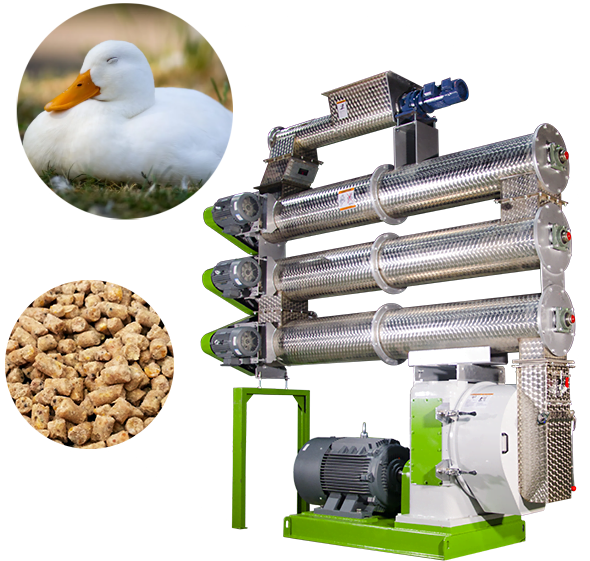
According to the duck feed production process flow, duck feed making machine usually includes raw material receiving and cleaning equipment, conveying equipment, raw material crushing equipment, batching equipment, raw material mixing equipment, feed pellet machine equipment, extrusion equipment, liquid spraying equipment, ventilation and dust removal equipment, packaging equipment and automatic electronic control system.
- Capacity: 1-100T/H
- Complete equipment price: 10,000-3,500,000 USD
- Type: Meat duck feed equipment and laying duck feed equipment
- Application: Can be used to process 2-6 mm duck and goose feed pellets, powdered feed, and fermented feed
- Duck feed ingredients: corn, barley, wheat, oats, fish meal, meat and bone meal, soybean meal, soybean oil, corn oil, minerals, vitamins, etc.
RICHI can provide you the best range of duck feed machine 1-100t/h, computerized duck feed machine, high performance duck feed machine, semi automatic duck feed machine, fully computerized duck mesh feed machine and duck feed pellet mill with effective & timely delivery.
Composition of whole set duck feed machine
As important equipment in feed production, key stand-alone equipment such as duck feed pellet machines, duck feed mixers, and duck feed crushers must be in good production condition at all times.
If you want to process duck feed pellets and maintain the normal operation of a duck feed factory, you need a lot of duck feed machines. Here is a list of some major equipment for duck feed processing:
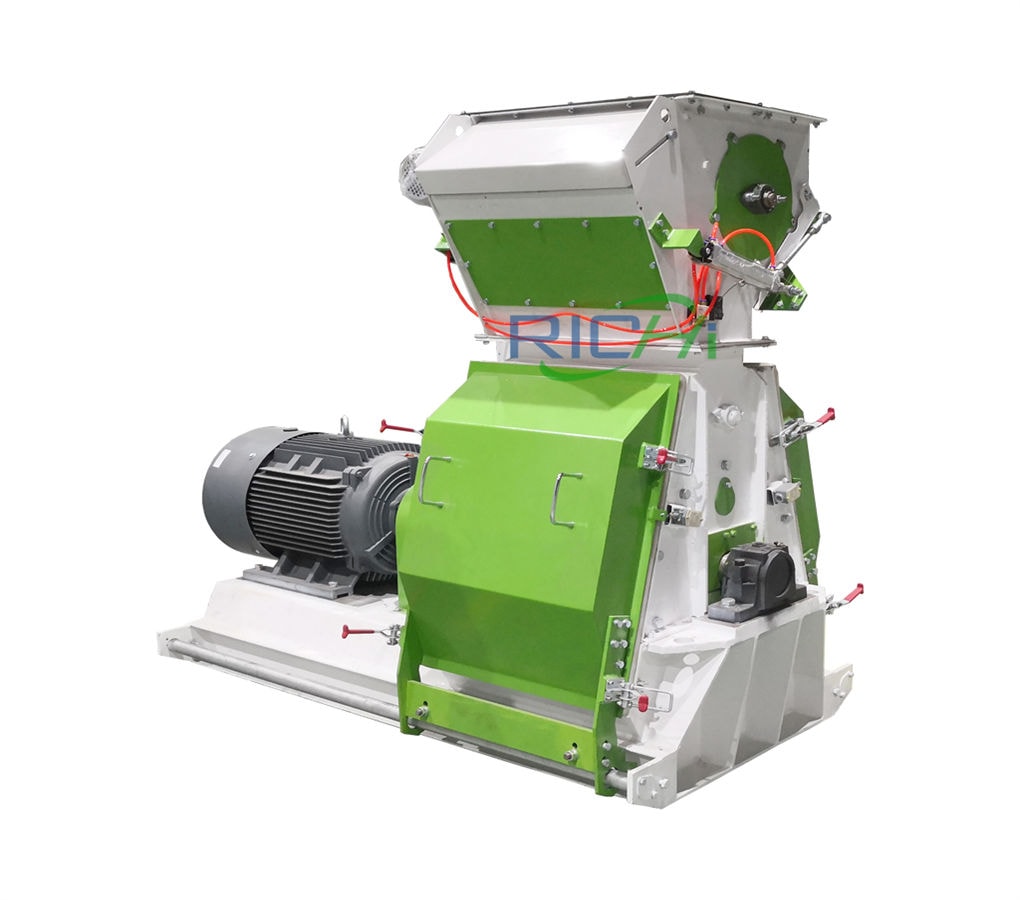
Duck feed hammer mill grinder
RICHI duck hammer mill feed grinder has high production capacity and low energy consumption. The optimal rotor has two configurations, which are suitable for crushing raw materials of duck feed to improve their respective efficiencies.
- Capacity: 3-25 T/H
- Power: 30-160 KW
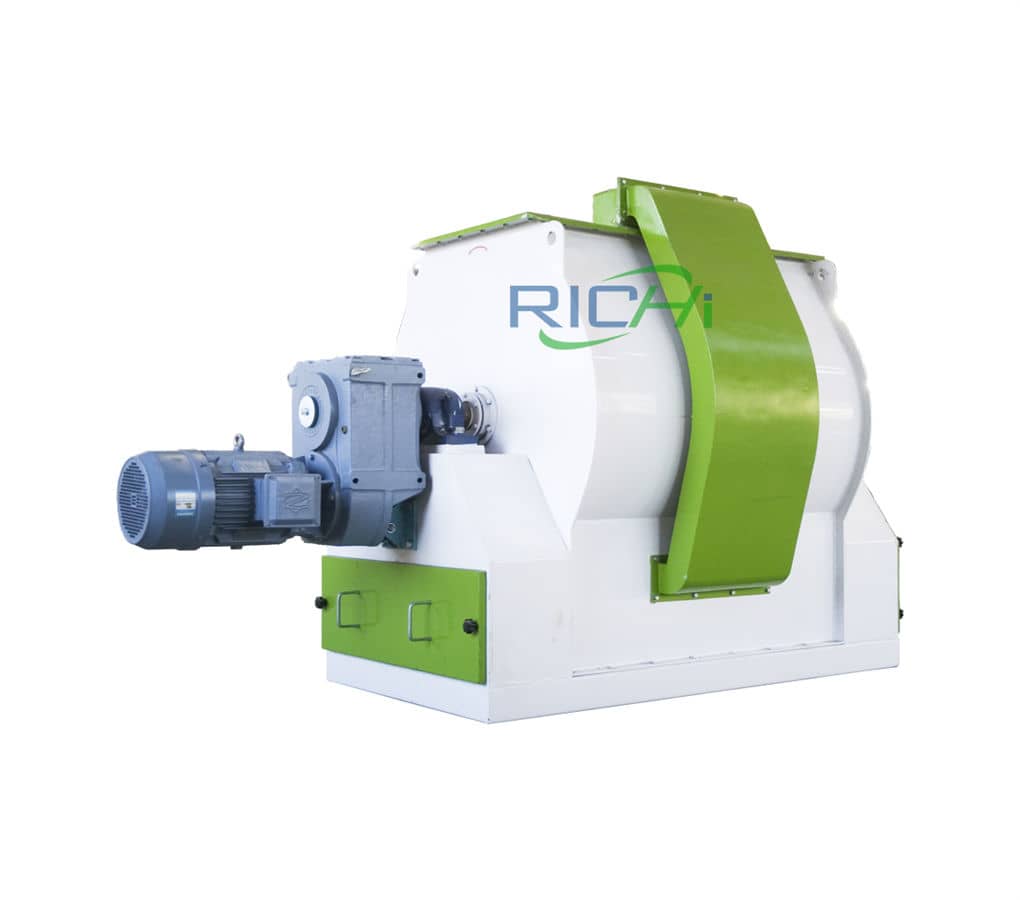
Duck feed mixing machine
Duck feed mixers are widely used for mixing powdery, granular, flake, block, miscellaneous and viscous materials in feed, grain, food, chemical, pharmaceutical, pesticide and other industries.
- Capacity: 250-3000 KG/P
- Power: 4-55 KW
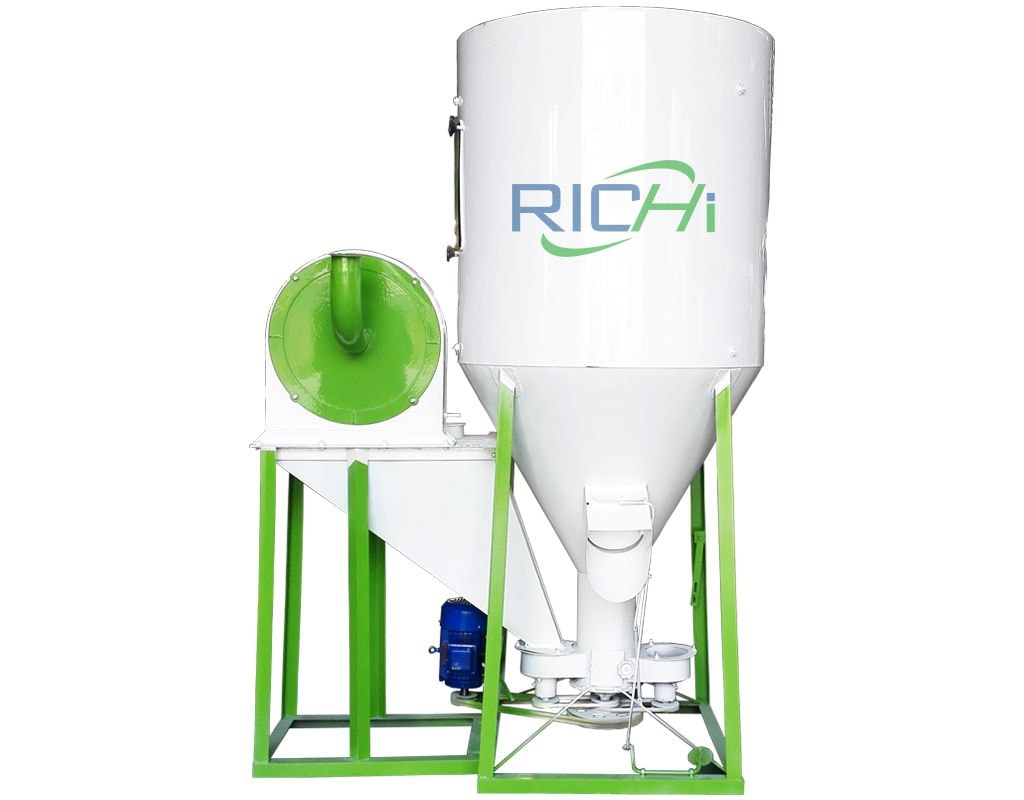
Liquid adding machine
It is used to add grease or other liquids when compound feed is mixed in the mixer, and is suitable for batch mixers. It has a compact structure and is equipped with high-precision online flow measurement, which can realize online continuous metering and refueling.
- Adding Rate: 50-200 L/Min
- Power: 2.2-5.5 KW
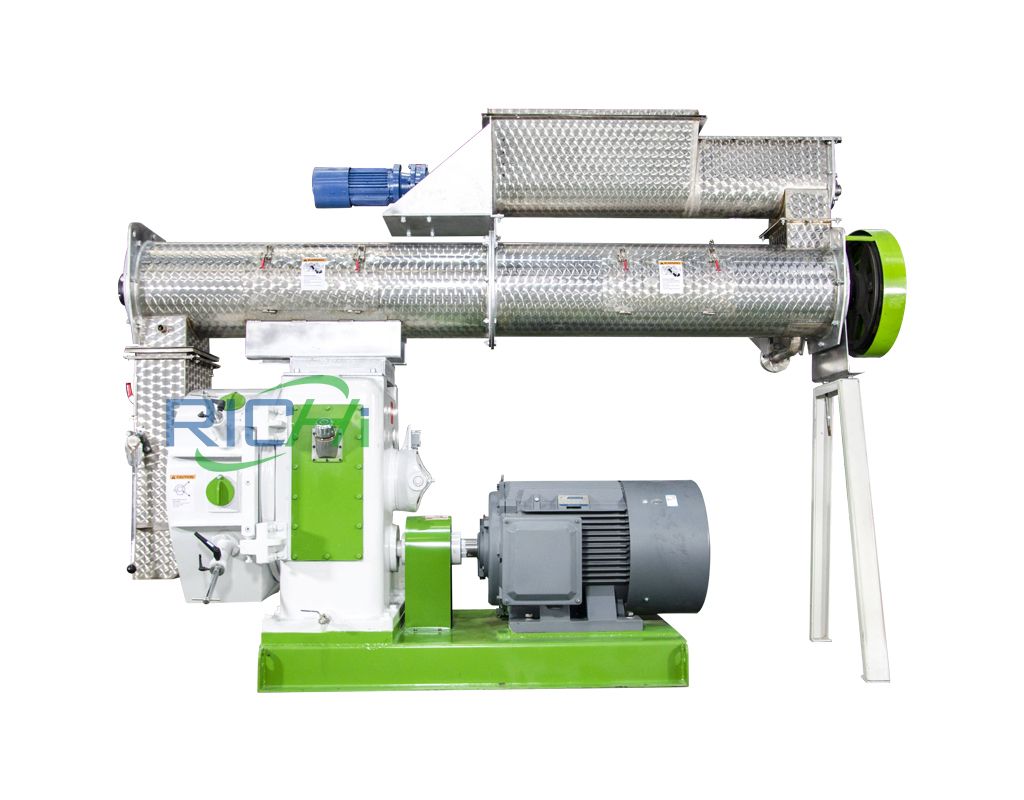
Duck feed pellet making machine
The SZLH series duck feed pellet mill is a novel pellet feed pellet mill produced by RICHI’s proprietary technology. This duck feed machine machine is equipped with high-quality ring molds, pressure rollers and advanced technology.
- Capacity: 1-42 T/H
- Power: 22-315 KW
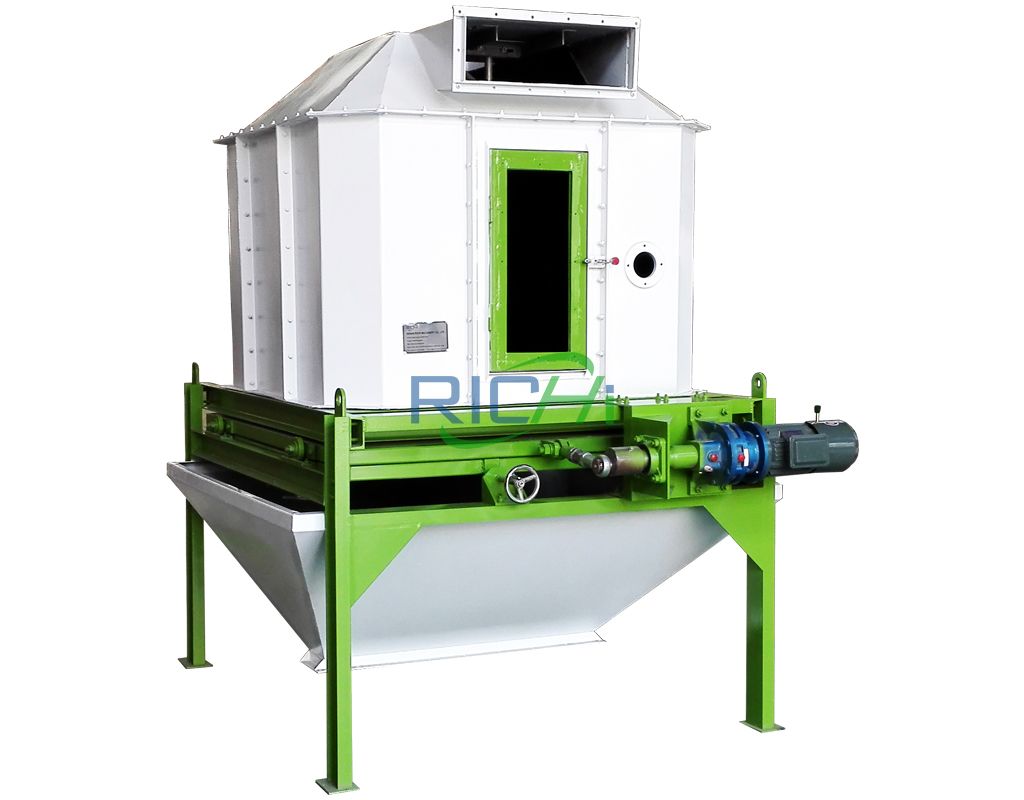
Duck feed pellet cooling equipment
The duck feed cooling machine adopts the advanced counter-current cooling principle and adopts a discharge fence-type discharge mechanism with reciprocating linear motion, which ensures smooth discharge and uniform discharge volume. Vertical overall layout, simple and beautiful appearance.
- Capacity: 1.5-18 T/H
- Power: 0.75-2.05 KW
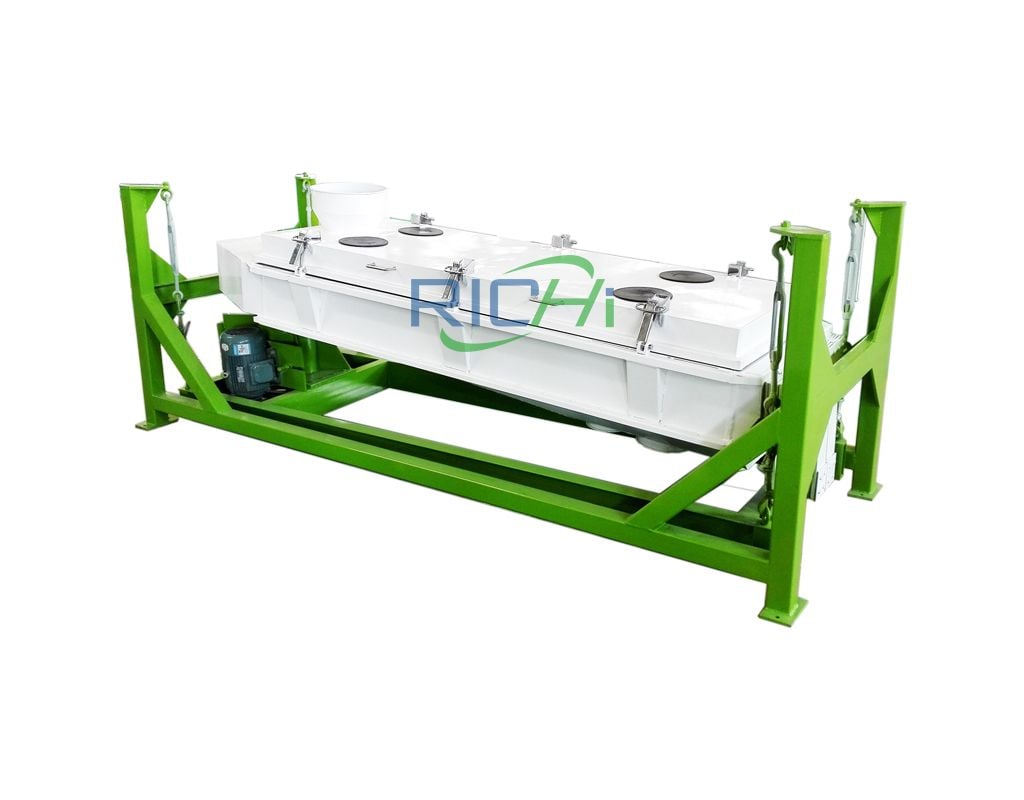
Screening equipment
Vibrating cleaning screens are mainly used for cleaning or grading raw materials in feed mill, flour milling, breeding, rice milling, chemical industry, food and other industries. By replacing the screens with different apertures, various granular materials such as wheat, corn, rice, oilseeds, etc. can be cleaned.
- Capacity: 3-20 T/H
- Power: 1.5-5.5 KW
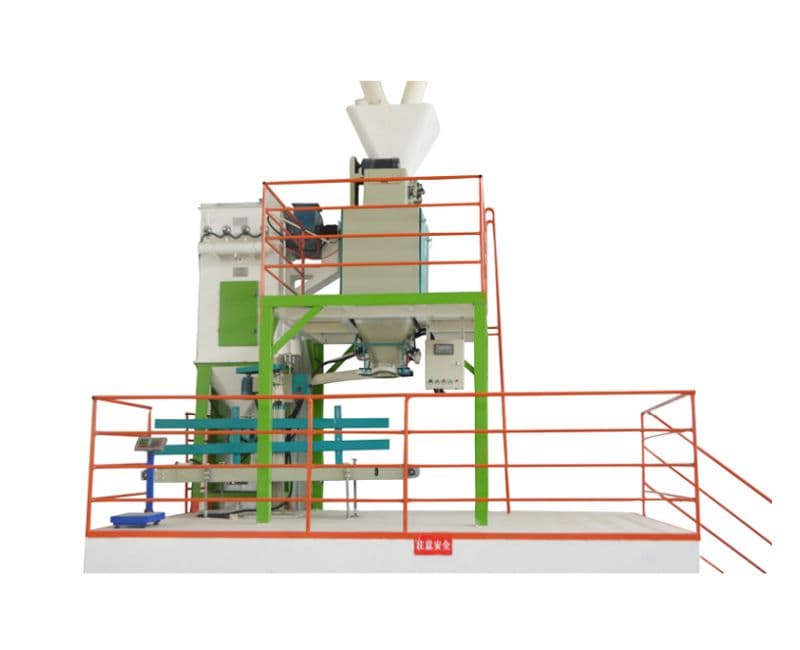
duck feed Packing equipment
Automatic bagging machines are suitable for quantitative packaging of granular and powdery materials and are widely used in grain, feed, food, light industry, chemical industry and other industries. The main machine adopts fast, medium and slow three-speed control, spiral feeding, high metering accuracy and fast speed.
- Speed: 6-12 Bags/Min
- Power: 1.1-5 KW
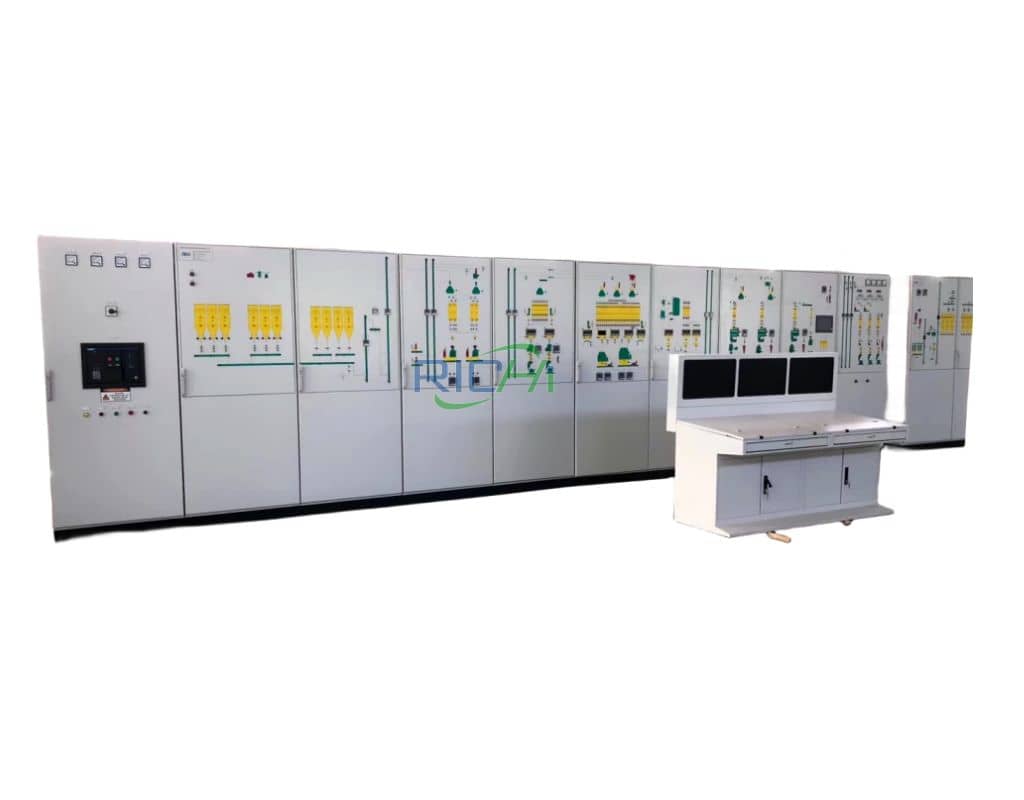
electronic control equipment
Including analog screen control system, full screen control system, and electrical control system. Start or stop in sequence according to process requirements, with interlocking and logical functions; display a complete process picture, and monitor the equipment operating status in real time.
- MCC Control Center;Mimic control panel (power range from 22 kw to 55 kw for star triangle start)
Based on the similarity between duck feed and goose feed, duck feed equipment can also be used to process goose feed.
If you want to process duck and goose feed, if you are looking for duck feed machine of large scale, medium scale or small scale, RICHI Machinery should be your first choice and we can ensure to offer the best wholesale price and all the duck feed processing machines are sold directly from our factory – RICHI ! Just feel free to contact us for detailed quotation list!
How to produce duck feed pellets?
The following is a detailed introduction to the process flow of duck feed machine system:
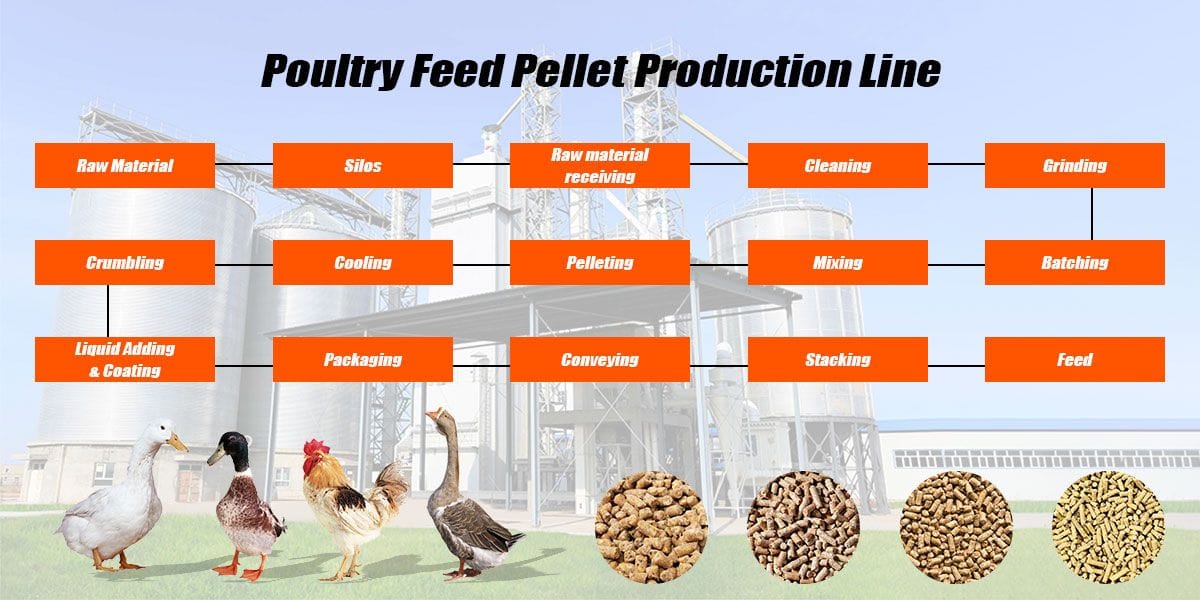
01 Raw material cleaning
Bulk raw materials corn and soybean meal are received; the cleaning process is to enter all operating units of the silo that have passed the inspection by the raw material inspector. In this process, impurities in the raw materials are first removed using impurity removal equipment, and then transported to the silo as planned through receiving equipment and demagnetization equipment.
The duck feed making equipment includes receiving devices (such as discharge pits, platforms, etc.), conveying equipment, primary cleaning screens, and magnetic separation devices (such as permanent magnet drums, permanent magnet drums, etc.).
For the receipt of bagged raw materials, it means that the loading and unloading personnel unload the raw materials that have passed the inspection by the raw material inspector and store them neatly in the warehouse.
02 Ingredients process
The batching process is to weigh the raw materials in the batching bin from the feeder under each batching bin to the batching according to the formula requirements. After each raw material is weighed by the batching scale, the raw materials are transported to the powder storage bin.
The ingredients are weighed out from the silo. These weighed raw materials enter the powder silo. A small amount of materials and premixes are added and directly weighed manually and then put into the silo for mixing. The quality of the batching process directly affects the accuracy of product batching.
03 Crushing process
The crushing process means that the raw materials to be crushed in the silo are sent to the crusher to be crushed into powder, and then sent to the silo to be mixed by the conveyor before use. The purpose of this process is to control the particle size of the material.
The design efficiency of the duck feed crusher in this process determines the production capacity of the duck feed machine, and it is also the process with the largest energy consumption in the production of powdered materials. Monitor and confirm hammers, screens, current, noise and crushing paths at any time.
04 Mixing process
During the mixing process, various crushed raw materials are discharged from the mixing chamber into the mixer, and oil is added to the feed in the mixer through the liquid addition system as needed to mix the components evenly and achieve the required mixing effect uniformity. The material discharged from the mixer is the finished product, which is directly sent to the packaging process of the finished product for packaging and shipment.
When producing pellet feed, the mixed powder is sent to the silo for granulation. In order to ensure the efficiency of the duck feed mixer machine, maintenance personnel must regularly inspect and repair the equipment and regularly test the efficiency of the mixer machine for duck feed.

05 Pelleting process
The crushed and screened raw materials are mixed together in a certain proportion to form the basic formula of the feed. Put the mixed raw materials into a mixer and stir to fully mix the raw materials evenly to improve the nutritional value and palatability of the feed.
If you want to process powdered feed for laying hens, it can be packaged directly after mixing. If pellet feed is to be processed, continue with the next process. As of this process, have answered many people’s questions about “how to make layer mash for chickens”.
06 Pelleting process
After the mixed materials are magnetically separated and conditioned from the granulation bin, they are sent to the compression chamber of the duck feed granulator, compressed into pellet feed. Magnetic separation equipment must be cleaned regularly to prevent iron impurities from causing damage to the duck feed pellet mill machine.
During conditioning, the amount of steam should be adjusted according to the pellet variety requirements, and the ring die (pore diameter, compression ratio, material, etc.) should be selected according to the pellet process quality requirements.
07 Cooling and screening process
After pelletized by duck poultry feed pellet making machine, the pellet will be cooled by the cooling tower, and screened by screening equipment to obtain standard granules.
During cooling, the cooling tower should be adjusted according to factors such as variety, indoor temperature and humidity, season, etc., to achieve qualified pellet temperature and humidity. Adjust the cooling tower according to factors such as variety, indoor temperature and humidity, season, etc. to achieve qualified particle temperature and humidity.
Then the duck feed pellets with qualified size are screened out through the screening equipment, and the unqualified pellets or powder will be returned to the crushing or granulation section for granulation.
08 Finished product packaging process
The feed is weighed from the finished product warehouse through a packaging scale, put into packaging bags, and then the packer inserts the label and seals it, and then is transported to the warehouse by a transport truck for stacking.
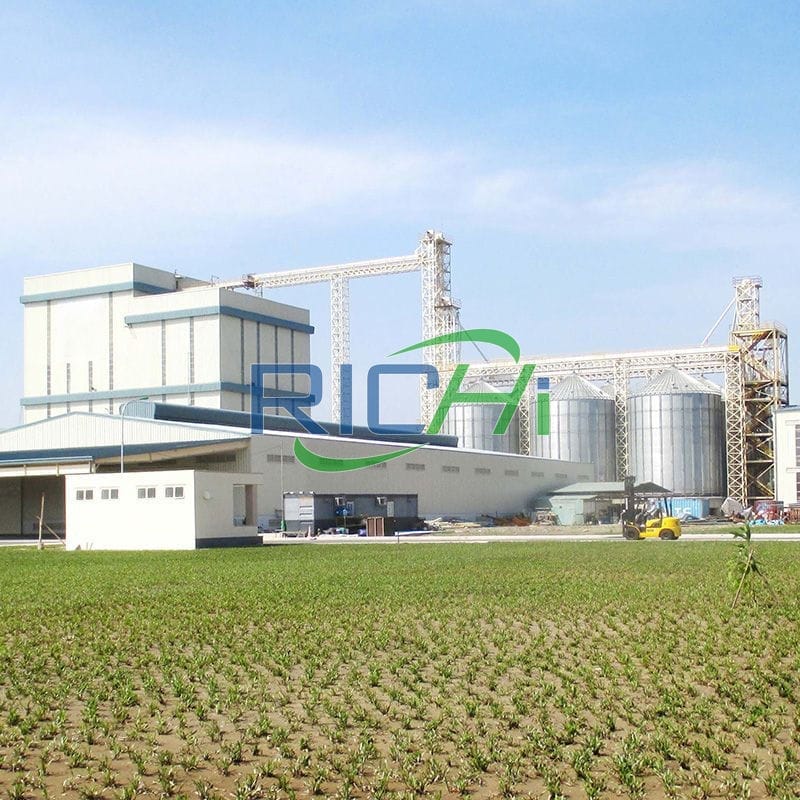
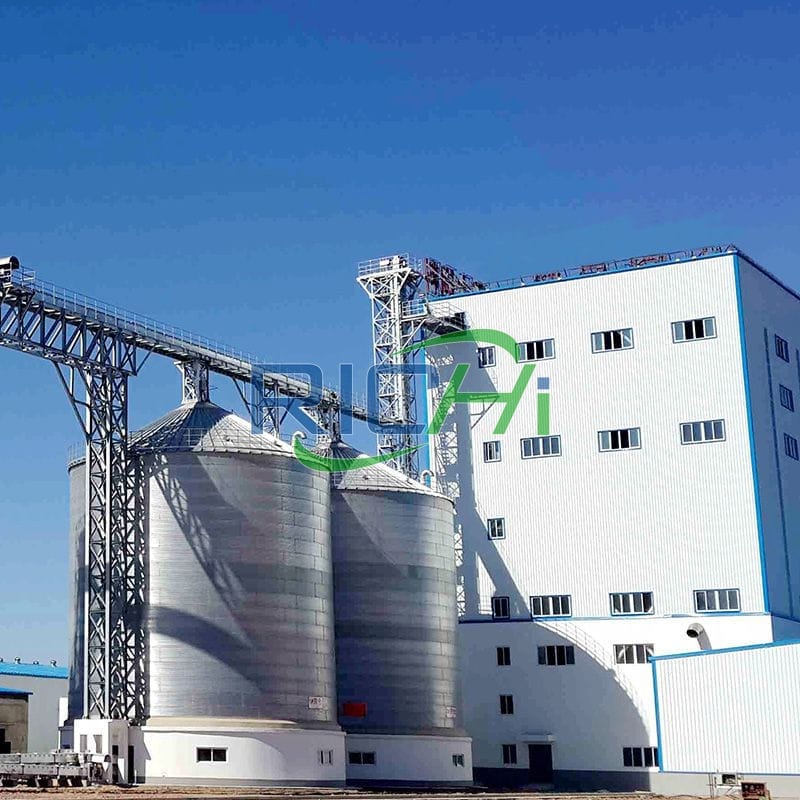
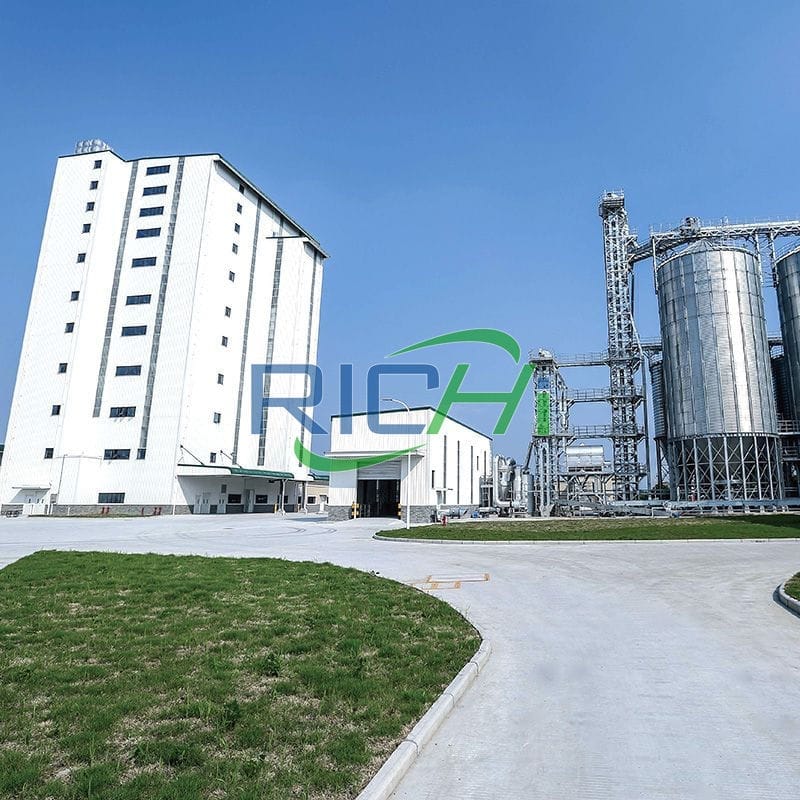
RICHI is the brand name of duck feed machine manufactured by RICHI Machinery. This duck feed mill equipment can be widely used for making fish feed, cattle feed, pig feed, and chicken feed. So some people also call it poultry feed making machine or livestock feed machine.
Actually, RICHI duck feed making machine has a much wider application field such as making feed for cattle, chicken (broiler and layer), pig, duck and many other livestock. The diameter and size of final pellets is adjustable. You can decide the size and ingredient depending on the eating habits of each animal. (Find RICHI on YouTube)
Standards for qualified duck feed
Using RICHI duck feed technology and duck feed machine, the duck feed produced will meet the following standards:
- Raw materials: must comply with relevant standards or the duck feed company’s raw material quality requirements.
- Sensory: The color should be consistent, without fermentation, mildew, agglomeration, odor or smell.
- Moisture: should be no more than 13.5% from May to August, and no more than 14.0% in other months.
- Mixing uniformity: Mixing should be uniform, and the coefficient of variation (CV) of mixing uniformity should not be greater than 7%.
- Shelf life: Under the specified packaging, storage and transportation conditions, the shelf life is 30 days from the date of production.
Finished feed product size:
Powder:
All materials should pass through the 6.00mm aperture analysis sieve.
Pellets:
- Duck feed pellet diameter ≤ 6.0mm, length ≤ 15mm.
- The powder content should not be greater than 10.0%.
- The powdering rate should not be greater than 10.0%
- This standard applies to duck compound feed.
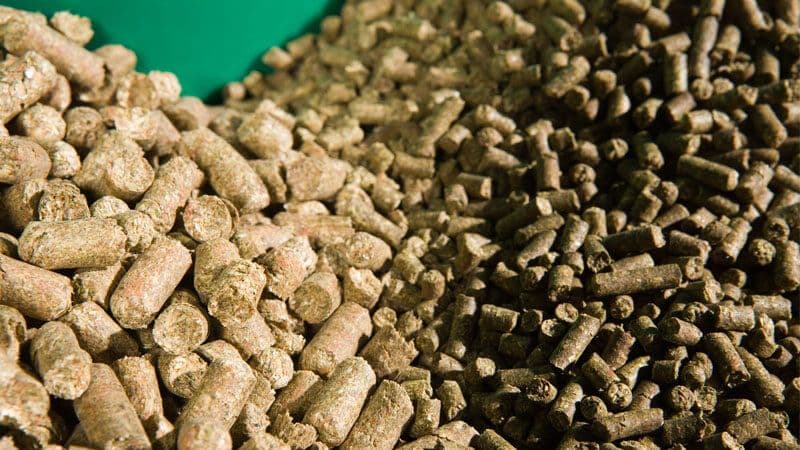
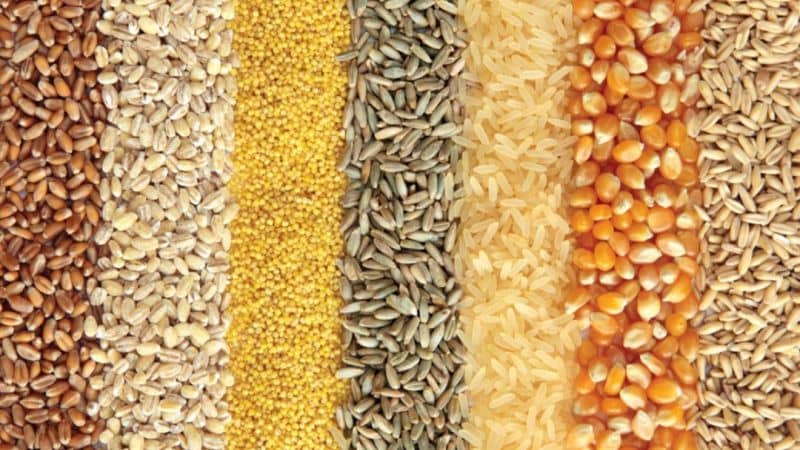
Nutritional composition requirements of different duck feeds
| Item | Compound feed for ducklings |
| Crude protein % ≥ | 20.0 |
| Crude fiber % ≤ | 6.0 |
| Coarse ash content % ≤ | 9.0 |
| calcium % | 0.7~1.5 |
| Total phosphorus % ≥ | 0.5 |
| Sodium chloride % | 0.2~0.8 |
| Methionine % | 0.35~0.9 |
| Item | Feed for medium and large ducks |
| Crude protein % ≥ | 14.5 |
| Crude fiber % ≤ | 8.0 |
| Coarse ash content % ≤ | 10.0 |
| calcium % | 0.7~1.5 |
| Total phosphorus % ≥ | 0.5 |
| Sodium chloride % | 0.2~0.8 |
| Methionine % | 0.3~0.9 |
| Item | Compound feed for laying ducks |
| Crude protein % ≥ | 17.0 |
| Crude fiber % ≤ | 7.0 |
| Coarse ash content % ≤ | 16.0 |
| calcium % | 2.5~5.0 |
| Total phosphorus % ≥ | 0.55 |
| Sodium chloride % | 0.2~0.8 |
| Methionine % | 0.3~0.9 |
Duck feed machine projects
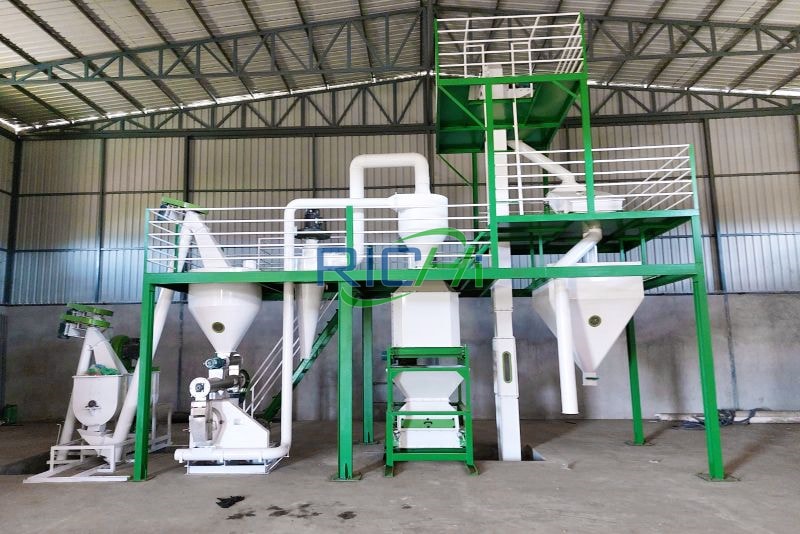
1-2T/H duck feed machine in Australia
- Date: June 10, 2020
- Feed type: laying duck feed
- duck feed mill plant cost: 25,000-29,000 USD
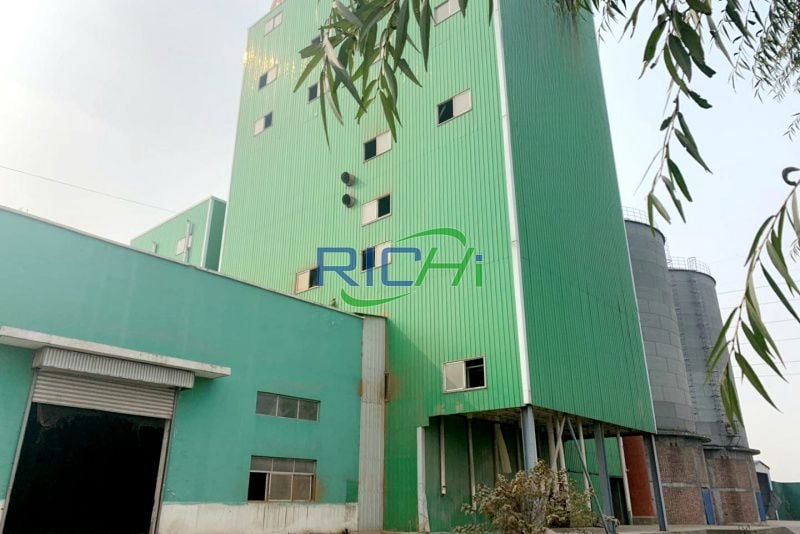
15-20T/H duck feed machine in China
- Date: December 2020
- Feed type: meat duck feed
- duck feed mill plant cost: 500,000 USD
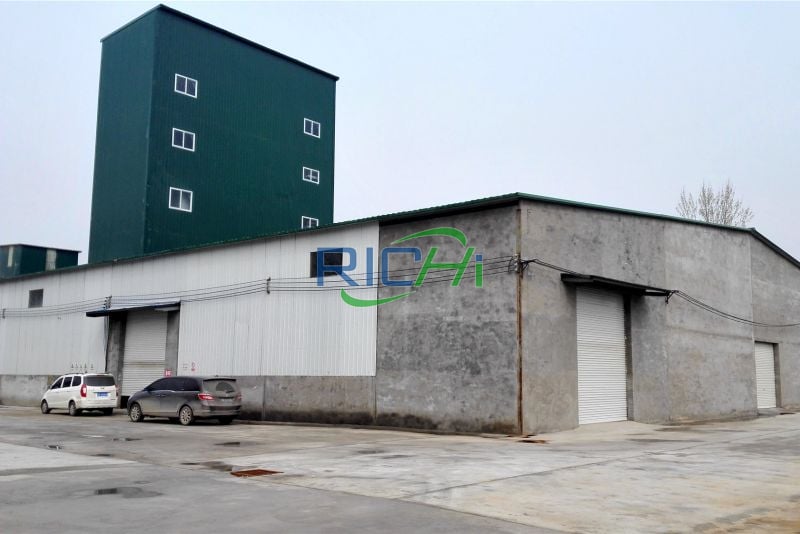
5-7 t/h duck feed machine in Myanmar
- date: 2022.02.09
- Feed type: layer duck pellets
- duck feed mill plant cost: 97160 USD
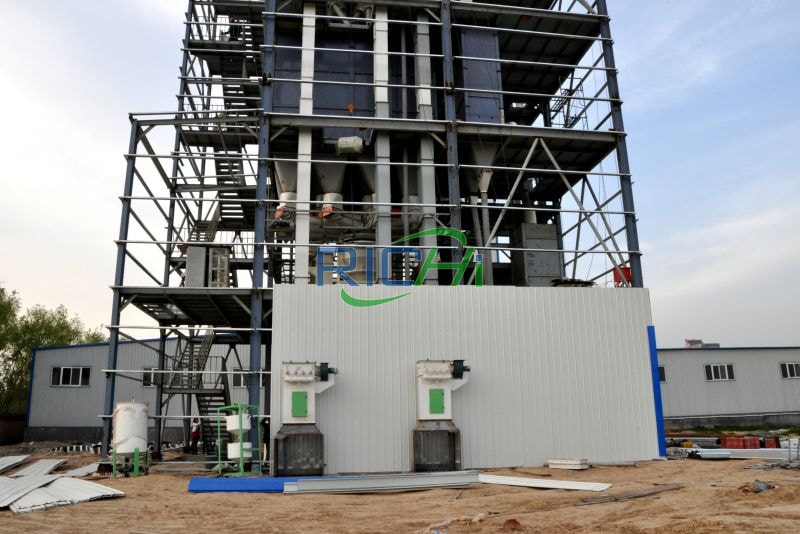
10T/H duck feed machine in the Russia
- Project date: 2023.09.13
- Feed type: meat duck feed
- duck feed mill plant price: 460,000 USD
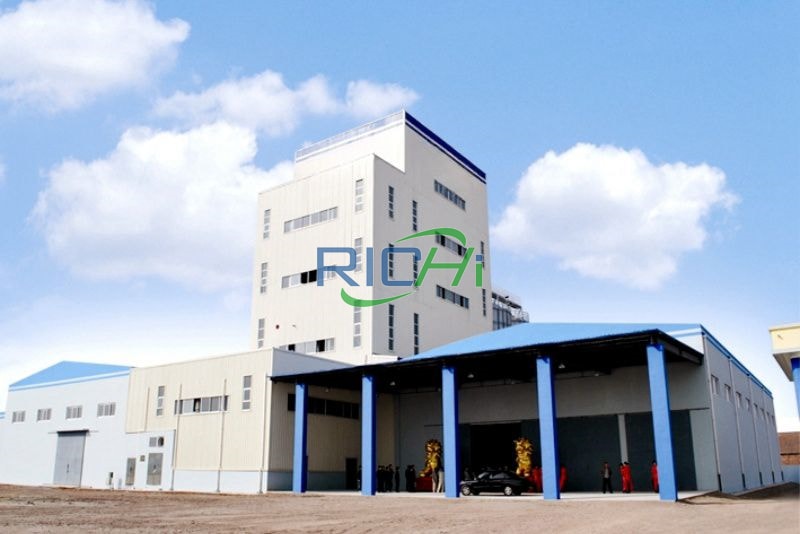
6-10T/H duck feed machine in USA
- Date: Sep 21th, 2015
- Feed type: layer duck feed
- duck feed mill cost:80,000-400,000 USD
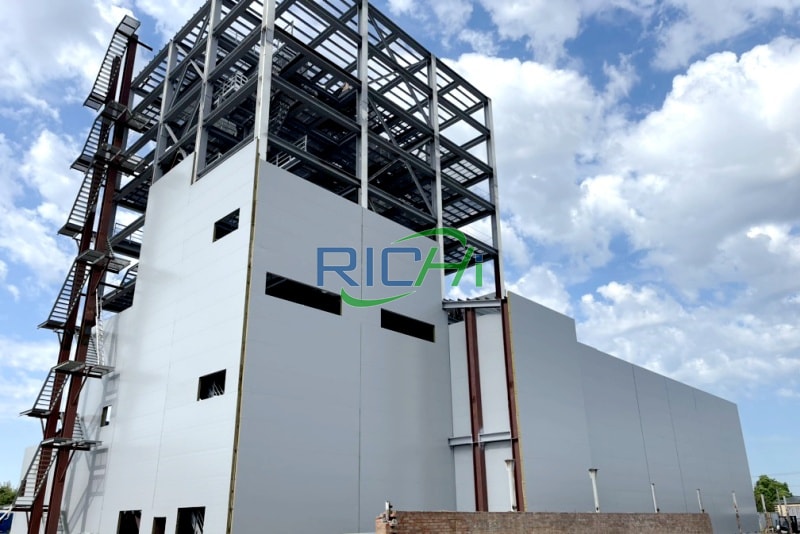
10-15T/H duck feed machine in France
- Date: July 6th, 2019
- Feed type: layer & meat duck feed
- duck feed mill cost: 150,000-400,000 USD
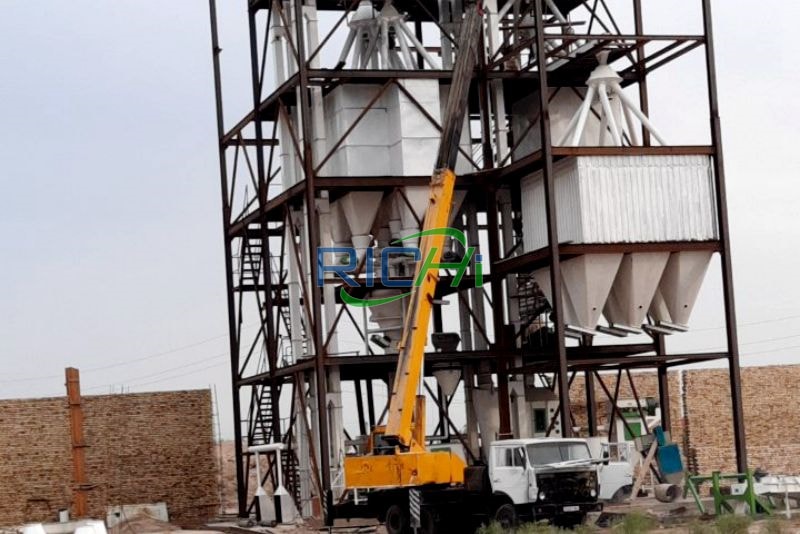
5T/H duck feed machine In Vietnam
- Date: February 2021
- Feed type: duck pellet & mash
- duck feed plant cost: 220,000-250,000 USD
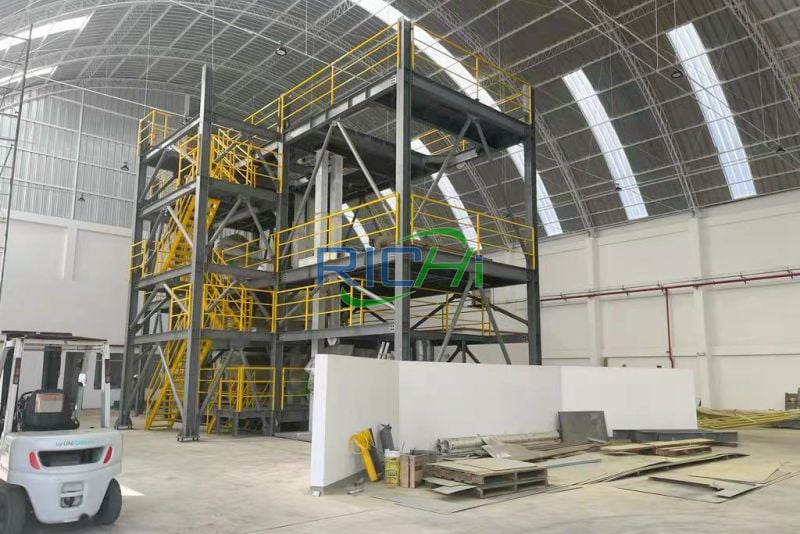
3-5T/H duck feed machine In Canada
- Date: October 29, 2021
- Feed type: laying duck feed
- duck feed plant cost: 60,000-65,000 USD
Duck feed machine price
01 Single duck feed machine price
The price of a fully automatic duck feed production line will vary depending on the type and scale of duck feed machine included. Generally speaking, the price of a fully automatic duck feed mill plant ranges from hundreds of thousands to millions. The specific price needs to be determined based on factors such as equipment size, configuration, model, brand, and animal feed mill plant layout.
Here are the duck feed machine price ranges for some common devices:
- duck feed grinder price: 5300-35000 USD
- duck feed Mixer machine price: 2800-36500 USD
- Duck feed pellets machine price: 7000-100000 USD
- duck feed Cooler price: 4000-20000 USD
- duck feed Vibrating screen price: 2000-10000 USD
- duck feed Packing scale price: 5000-10000 USD
In addition to the price of the duck feed machine itself, costs such as transportation, installation and commissioning, and training also need to be considered. RICHI will also provide after-sales service and technical support, but RICHI’s after-sales service and technical support are all free and accompany the entire use cycle of the complete set of equipment.
In addition, factors such as the service life of the duck feed plant and maintenance costs also need to be considered. The following is a price reference for a complete set of duck feed making equipment.
02 Complete duck feed machine system cost
When investing in a duck feed processing plant, you need to consider many factors, such as factory rental or purchase costs, equipment purchase costs, labor costs, raw material costs, water and electricity bills, etc. The price of a complete duck feed machine and duck feed pellet production line is directly proportional to the output, degree of automation, and animal feed mill equipment configuration.
- 1-2 t/h duck feed line cost: 10000-50000 USD
- 3-4 t/h duck feed line cost: 50000-120000 USD
- 5-7 t/h duck feed line cost: 70000-250000 USD
- 8-10 t/h duck feed line cost: 150000-300000 USD
- 12-20 t/h duck feed line cost: 250000-580000 USD
- 25-40 t/h duck feed line cost: 450000-850000 USD
- 50-60 t/h duck feed line cost: 900000-1400000 USD
- 60-80 t/h duck feed line cost: 1450000-1800000 USD
- 80-100 t/h duck feed line cost: 2000000-2800000 USD
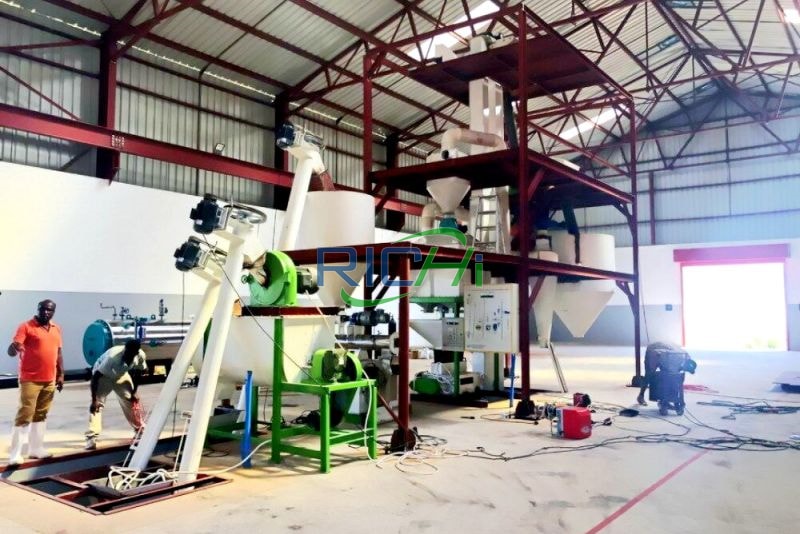
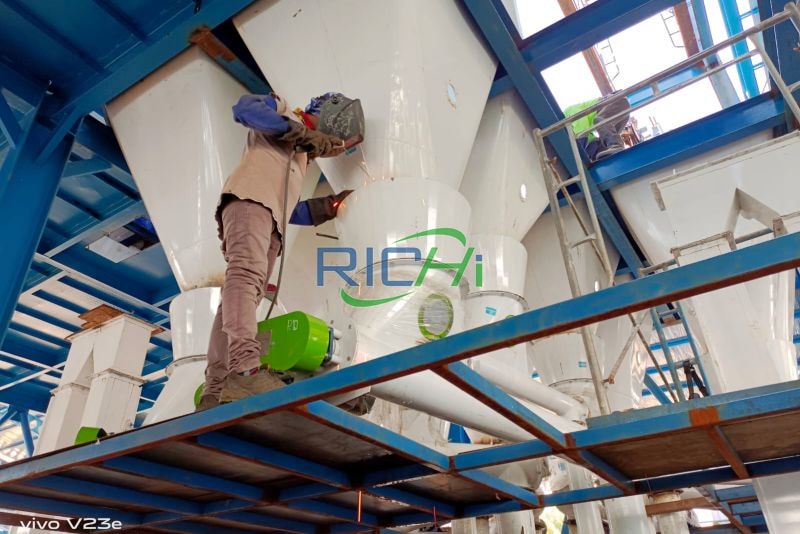
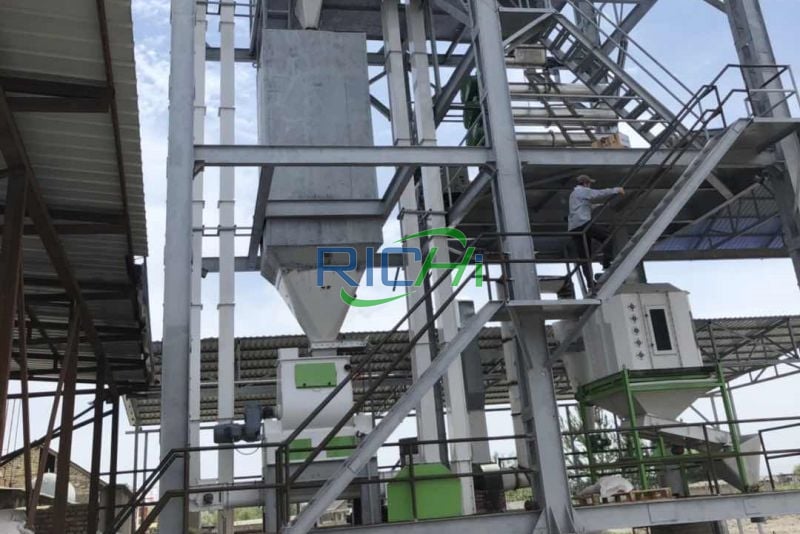
When investing in a duck feed machine plant, you need to pay attention to the following points:
- Market analysis:
It is necessary to conduct research on the local market to understand market demand, market size and competition to ensure the feasibility of investment. - Equipment selection:
Duck feed machine needs to be selected based on processing scale, production technology, raw materials and other factors to ensure stable and efficient operation of the duck feed production line. - Raw material procurement:
Factors such as supply channels, quality and price of raw materials need to be taken into consideration, and long-term cooperative relationships with suppliers need to be established. - Personnel recruitment:
Production and management personnel with relevant skills and experience need to be recruited and provided with training and development opportunities. - Safety and environmental protection:
Relevant safety and environmental protection regulations need to be complied with to ensure that the production process does not cause pollution to the environment and at the same time protect the safety of employees.
RICHI duck feed machine can improve production efficiency, reduce labor costs, save time and human resources, thereby bringing more benefits to feed companies. When choosing to purchase a duck poultry feed production line, you need to fully understand the types and prices of equipment on the market, as well as your own needs and budget, make comprehensive considerations, and choose the product with the highest price/performance ratio.
In summary, investing in a duck feed machine system requires consideration of multiple factors, and a comprehensive market analysis and investment plan formulation are required to ensure the success and profitability of the investment.
How to choose suitable duck feed machine?
Duck feed making machines refers to a complete set of equipment that processes raw materials through crushing, mixing, granulating, packaging and other processes to produce duck feed that meets the needs of different duck feed manufacturers.
The selection of complete sets of duck feed machine directly affects the efficiency and quality of feed processing, and in turn affects the development of the breeding industry. So, how to choose a suitable complete set of duck poultry feed mill equipment? This article will introduce it from the following aspects:
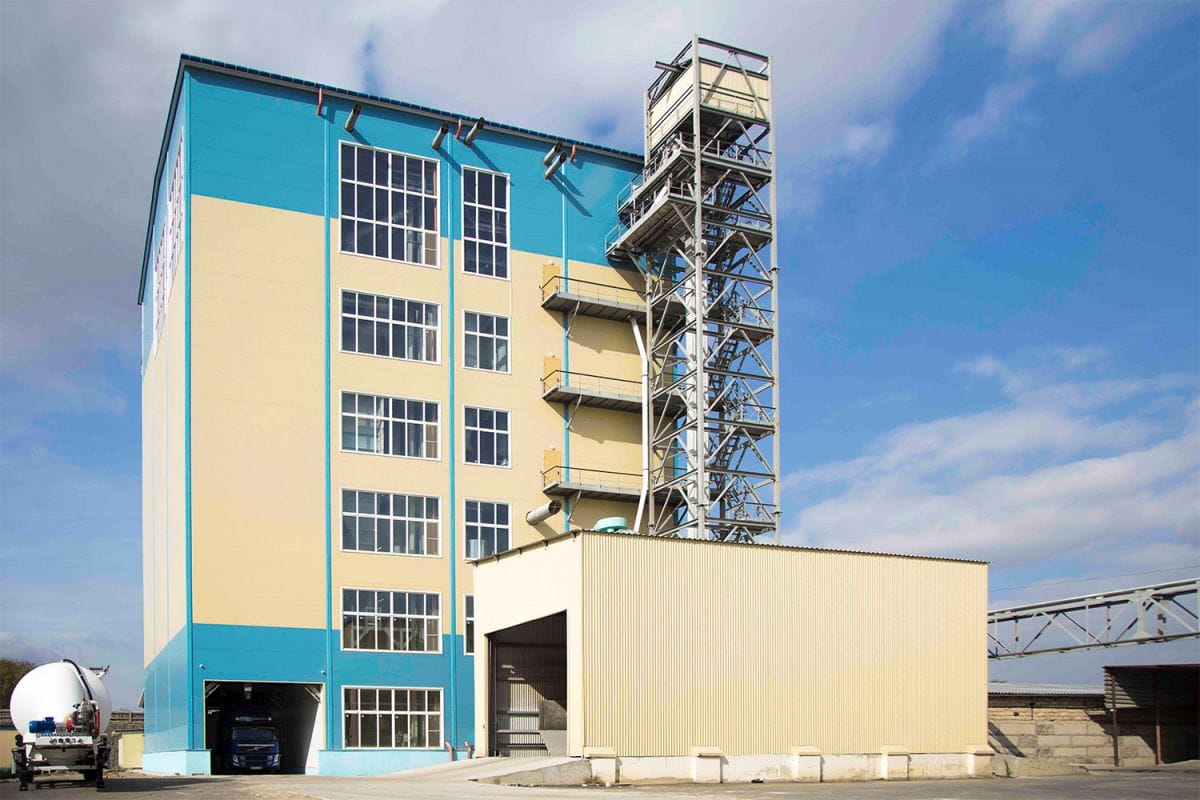

- Select the appropriate equipment model and configuration according to the scale and needs of duck feed processing.
Duck feed mills of different sizes have different requirements for equipment production capacity, degree of automation, energy consumption, etc. Generally speaking, the larger the scale, the higher the requirements for equipment performance and stability.
At the same time, the types and specifications of feed produced by the duck feed mill must also be considered to select duck feed machine that can meet diverse needs. - Select the appropriate equipment combination and layout according to the duck feed production process.
The technological process of duck feed making includes raw material processing, batching, mixing, granulation, cooling, screening, packaging and other processes. Each process requires corresponding equipment to complete. When selecting duck feed machine, consider the cooperation and coordination between equipment to avoid bottlenecks or waste.
At the same time, the layout of the equipment in the workshop must also be considered to make it reasonable, compact, and convenient for operation and maintenance. - Select appropriate equipment performance and parameters according to the quality standards of feed processing.
The quality standards for feed processing mainly include the nutritional composition, physical properties, health indicators and other aspects of the feed.
When selecting duck feed machine, you must consider whether the equipment can ensure that the nutritional value of the raw materials is not lost, whether it can produce duck feed pellets that meet the digestion and absorption characteristics of animals, and whether it can meet the health standards stipulated by the country or industry. - Select competitive and forward-looking equipment based on market conditions and development trends.
With the advancement of science and technology and changes in consumer needs, the duck feed processing industry is also constantly developing and innovating.
When selecting duck feed machine, you should consider whether the equipment has a high technical level and innovative capabilities, whether it can adapt to market changes and customer needs, and whether it can improve the competitiveness and profitability of the duck feed mill factory.
To sum up, choosing a suitable complete set of duck feed machines requires comprehensive consideration of many factors, and you cannot blindly pursue low price or high quality.
Only by choosing the duck feed making equipment that best suits you based on your actual situation and goals can you improve feed processing efficiency and quality and provide quality services to the breeding industry.
duck feed machine configurations with different capacity
Make a reasonable selection and comparison based on the user’s actual production site environment, output demand, product requirements, etc. The duck feed machine models are different according to the feed production required by the customer.
below are lists of Featured duck feed mill equipment with different capacity:
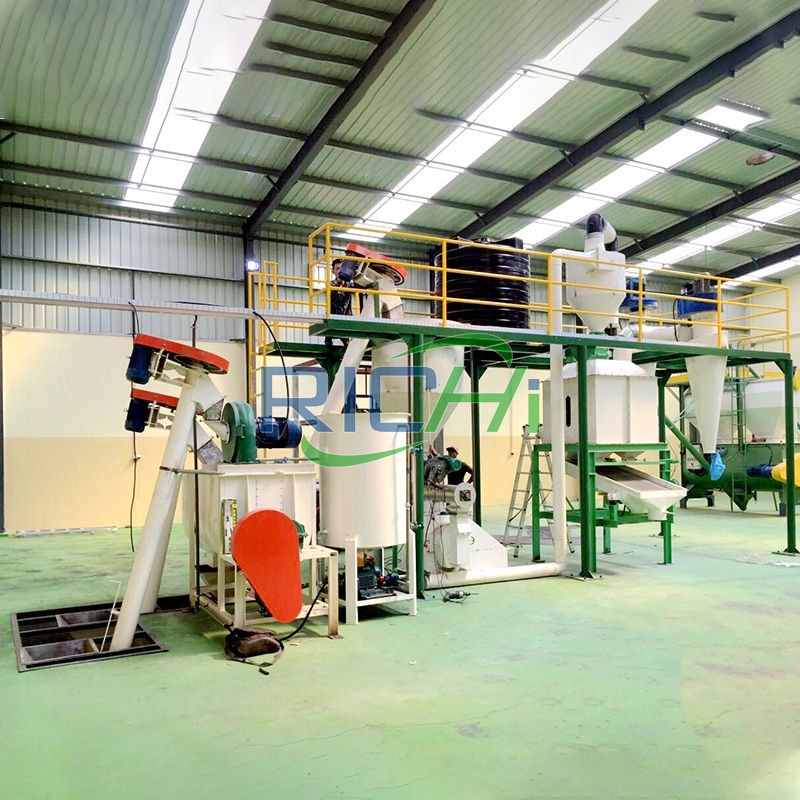
1-2 t/h duck feed mill machine configuration
| duck feed machine name | model | QTY |
| hammer mill for duck feed | 15-200 | 1 |
| duck feed Mixing machine | SLHY0.5A | 1 |
| Stainless steel condtioner | TZQ22*180 | 1 |
| duck Pellet machine | SKLH-250 | 1 |
| Conterflow cooling machine | SKLN1.0*1.0 | 1 |
| Vibrating sifter | ZDS60*1 | 1 |
| Cooling draught fan | 4-72-3.6A | 1 |
| Cooling cyclone | SK60 | 1 |
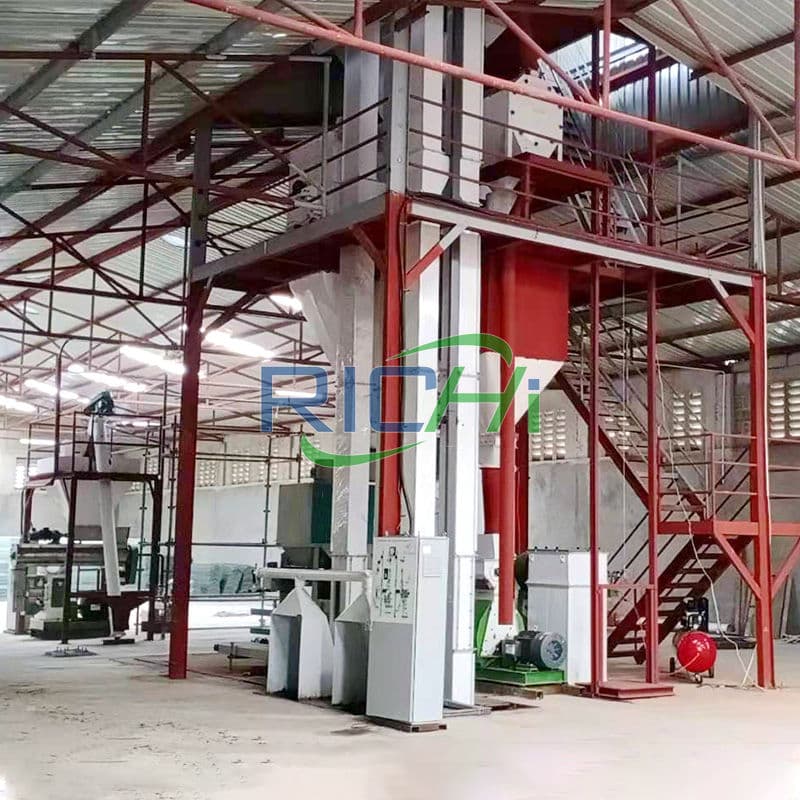
3-4 t/h duck feed mill machine configuration
| duck feed machine name | model | QTY |
| duck feed Hammer mill | SFSP56*60 | 1 |
| Mixing machine (Pneumatic door) | SLHY.1 | 1 |
| duck feed Pellet machine | SZLH320 | 1 |
| Stainless steel conditioner | TZ320*200 | 1 |
| duck feed pellet Cooling Machine | SKLN14×14 | 1 |
| Rotary screener | SFJH800*2C | 1 |
| Automatic Packing machine | DSC-50 | 1 |
| Sewing machine and belt conveyor | 1 |
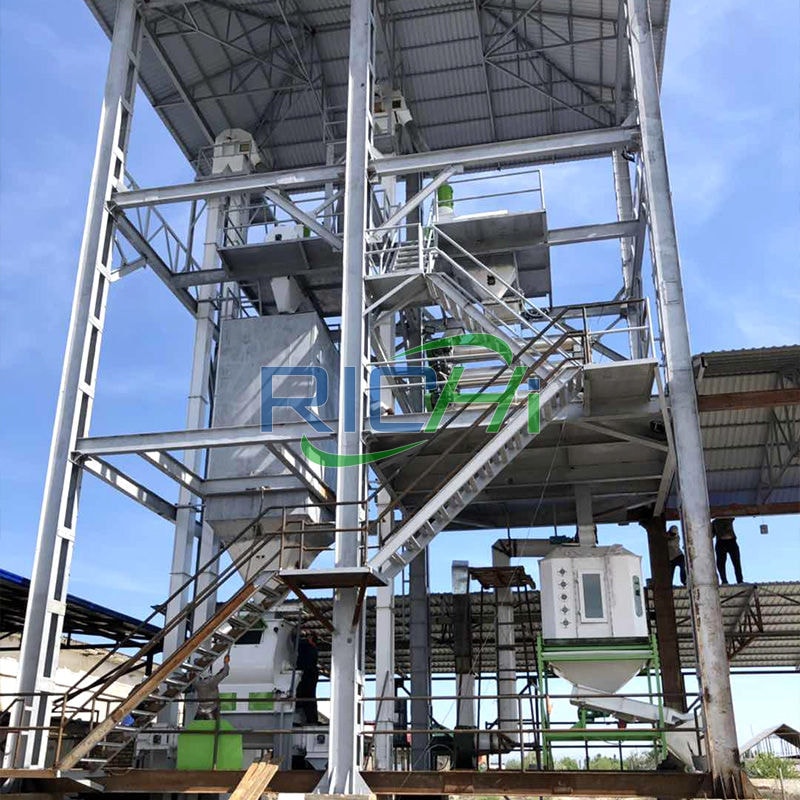
5-7 t/h duck feed mill machine configuration
| duck feed machine name | model | QTY |
| duck feed crusher | SFSP66*60 | 1 |
| Rotary distributor | TFPX6 | 1 |
| Batching scale | PLC0.5A | 1 |
| Mixing machine (Pneumatic door) | SLHY.1 | 1 |
| duck feed Pellets machine(1-Layer Conditioner) | SZLH350 | 1 |
| Cooling Machine | SKLN17x17 | 1 |
| Rotary screener | SFJZ100*2C | 1 |
| Automatic Packing machine | DCS-50 | 1 |
| Sewing machine+conveyor | / | 1 |
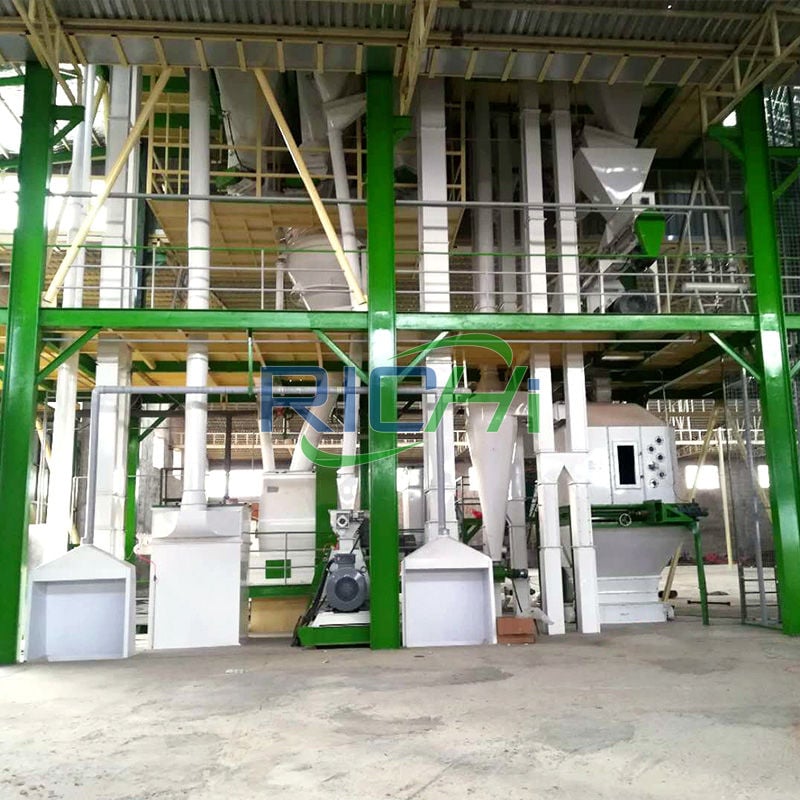
10 t/h duck feed plant machine configuration
| duck feed machine name | model | QTY |
| Duck feed grinder | SFSP66*60 | 1 |
| Double Ribbon Mixer | SLHY2.5L | 1 |
| Duck feed Pellet machine | SZLH420 | 1 |
| Stainless steel conditioner | TZ38*300 | 1 |
| Cooling Machine for Duck pellet | SKLN20×20 | 1 |
| Rotary screener | SFJH125*2C | 1 |
| Automatic Packing machine | DSC-50 | 1 |
| Sewing machine and belt conveyor | 1 |

15 t/h duck feed plant machine configuration
| duck feed machine name | model | QTY |
| Hammer mill for livestock feed | SFSP66*100 | 1 |
| Rotary distributor | TFPX8 | 1 |
| Batching scale | PLC1.5A | 1 |
| Single-shaft mixer for duck feed | SJHS3A | 1 |
| Pellet machine for duck feed | SZLH508 | 1 |
| Cooling Machine | SKLN24x24 | 1 |
| Rotary screener | SFJZ150*2C | 1 |
| Automatic Packing machine | DCS-50 | 1 |
| Sewing machine and belt conveyor | / | 1 |

25 t/h duck feed plant machine configuration
| duck feed machine name | model | QTY |
| Duck feed Hammer mill | SFSP66*80 | 1 |
| Duck feed Hammer mill | SFSP138*40E | 1 |
| Duck feed Mixing machine | SLHJ4.0A | 1 |
| Duck feed Pellet machine | SZLH420 | 2 |
| Cooling Machine | SKLN20x20 | 2 |
| Rotary screener | SFJZ125*2C | 2 |
| Automatic Packing machine | DCS-50 | 2 |
| Sewing machine&belt conveyor | / | 2 |
A duck animal feed production line includes but is not limited to the above configurations. The surrounding environment, physical and chemical properties of raw materials, discharging requirements, etc. will all affect the selection of duck feed machine.
Moreover, there are many models to choose from for the equipment configuration of each processing link, so basically the detailed configuration of the poultry feed production line will be different. If you also want to configure a duck feed production line that suits your needs, contact us to customize a duck feed mill plan and get a detailed duck feed machine quotation!
Qualified duck feed machine operating standards
—— RICHI MACHINERY ——
What are the requirements for duck feed processing machine in a duck feed factory? What operating standards does duck feed equipment need to meet to be qualified?
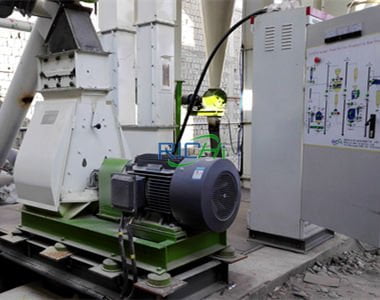
Requirements for duck feed crusher machines
The working temperature of the motor and main bearing is normal, the lubrication conditions are normal, the transmission protective cover is complete, the crusher door sealing effect is good, no dust leaks into the body, the rotor has good dynamic and static balance, no abnormal vibration, the hammer wear is even, the guide plate operates freely, and the body is protected All safety devices are in good condition.
The pneumatic device works reliably with no air leakage. The surface of the machine body is clean and dust-free. All signs are clear. The control system and electrical system are reliable and have forward and reverse functions. All ammeters, voltmeters, speed regulators, frequency meters, indicator lights and on-site emergency stop buttons are in good condition and work reliably.
Requirements for duck feed mixer machines
The operating temperature of the motor and reducer is normal, the reducer does not leak oil, the chain tension is reasonable and the lubrication is normal, the bearing lubrication is good, the protective cover is complete, there is no abnormal noise, the mixing quality is good.
There is no dirt in the body, and the door sealing effect is good, no material leakage, the connecting mechanism operates freely, the self-locking effect is good, the transmission chain tension is maintained, and the vibration of the transmission equipment caused by loose chain is avoided, the rotor clearance is reasonable, the residue is little.
The chemical effect is good, the surface of the duck feed mixer machine body is clean and dust-free; the air pipes and cable lines are arranged neatly, and there is no oil or air leakage. The signs are clear, the electronic control system is good, and the interlocking with the batching scale is reliable, which can meet production requirements.
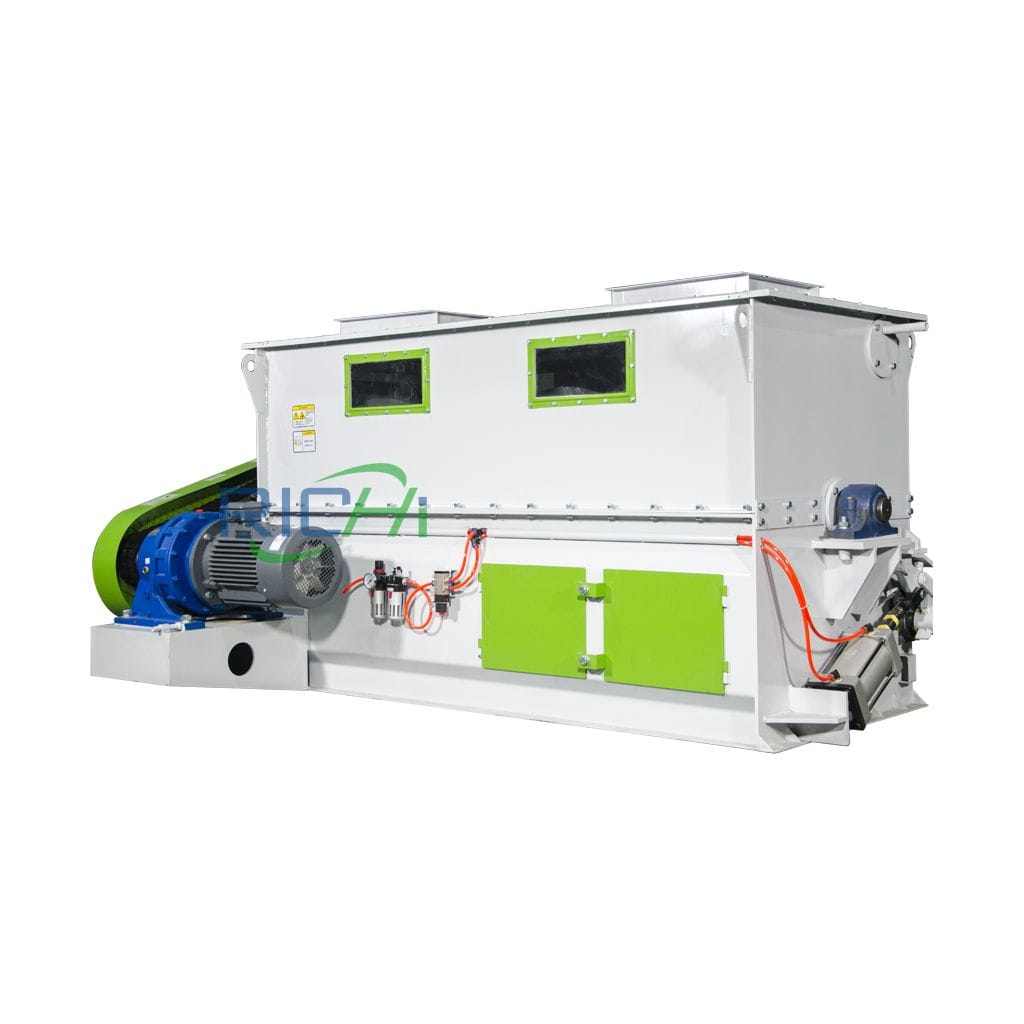
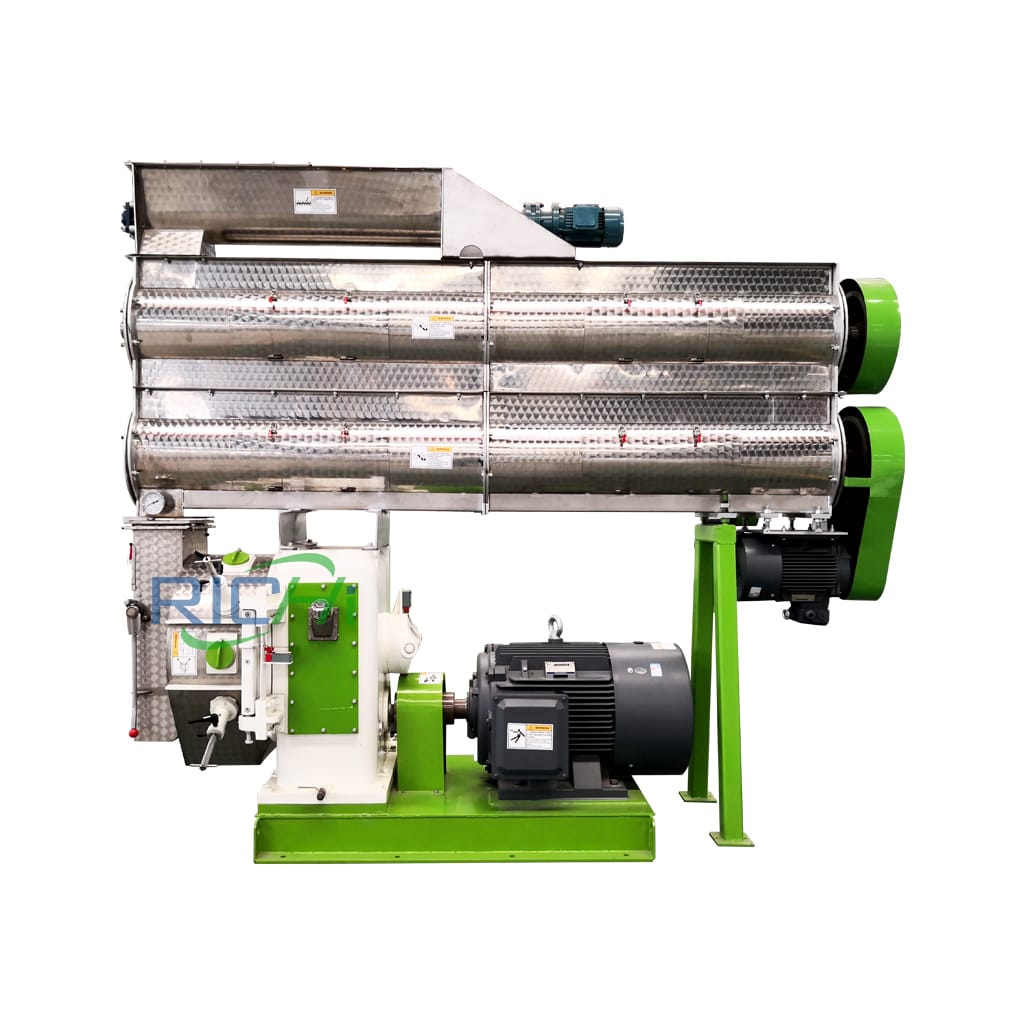
Requirements for duck feed pellet mill machines
The operating temperature of the motor and gearbox is normal and the lubrication conditions are intact. The transmission belt is properly tightened and there is no abnormal noise. The lubrication conditions of the main shaft and empty shaft of the duck feed pellet machine are good. The bearing clearance is within the normal range. The performance of the connecting fasteners of the main working parts is intact.
The clearance between the ring mold rollers is reasonable. The mutual wear is even, the gap adjustment mechanism is easy and accurate to adjust, all the attached devices on the machine such as cutters, magnetic separators, ring die hangers and special tools are in good condition, and all safety devices on the machine body are in good condition. The pneumatic device works reliably, with no air leakage.
The surface of the machine body is clean and dust-free, and all signs are clear. The interior of the duck feed machine is basically clean, and the control system and electrical system are reliable. All ammeters, voltmeters, adjustment tables, frequency meters, temperature meters, indicator lights and on-site control cabinets are in good condition. All components inside the cabinet are in good condition.
Requirements for scraper conveyor machines
The operating temperature of the motor and reducer is normal; the reducer does not leak oil; the transmission chain tension is reasonable, the lubrication conditions are normal, the protective cover is complete, the scraper in the machine is complete, the chain tension is appropriate, each bearing is well lubricated, and there is no abnormal noise during operation.
The conveying capacity reaches the designed output, the surface of the machine body is clean and dust-free, there is no oil leakage, and there is no powder leakage. The machine body is well sealed, each sign is clear, the operation process is smooth, and the control system works reliably.
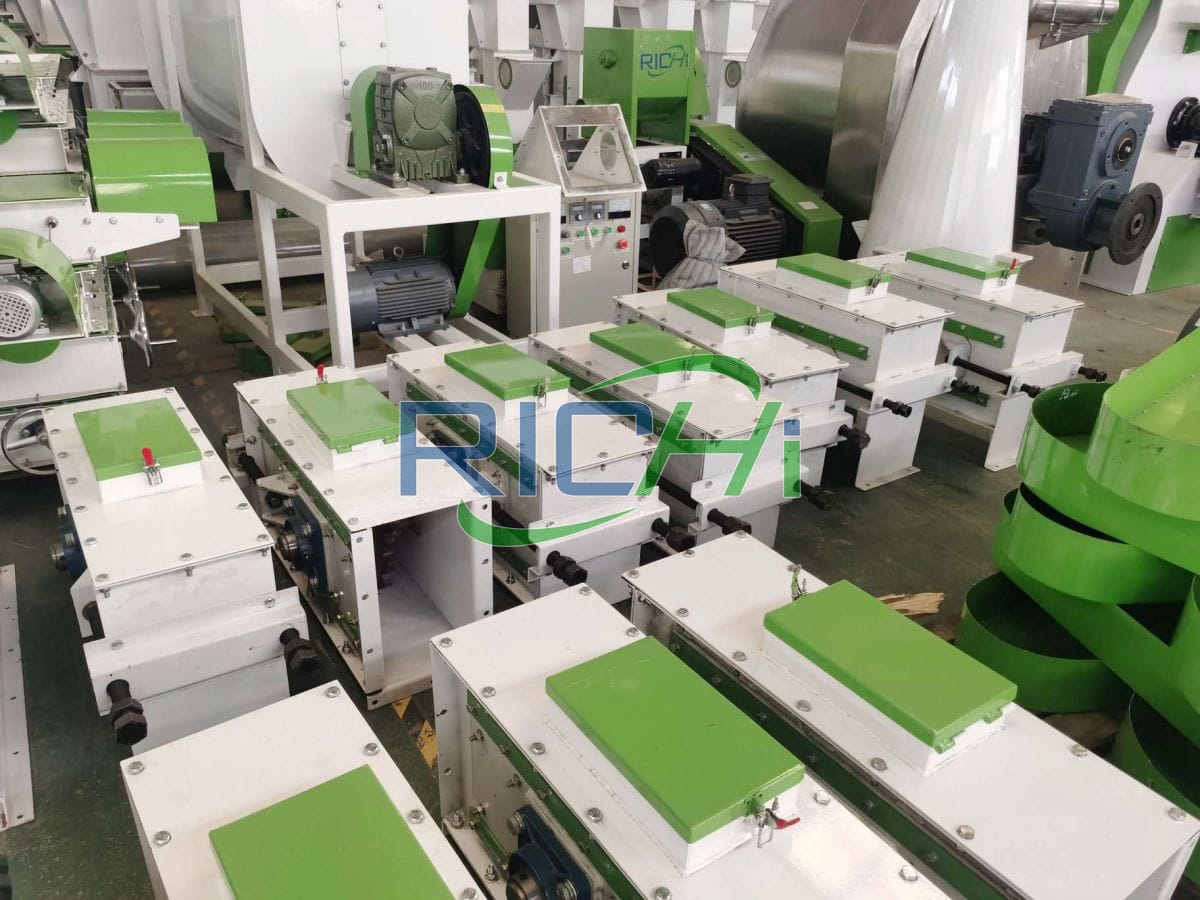
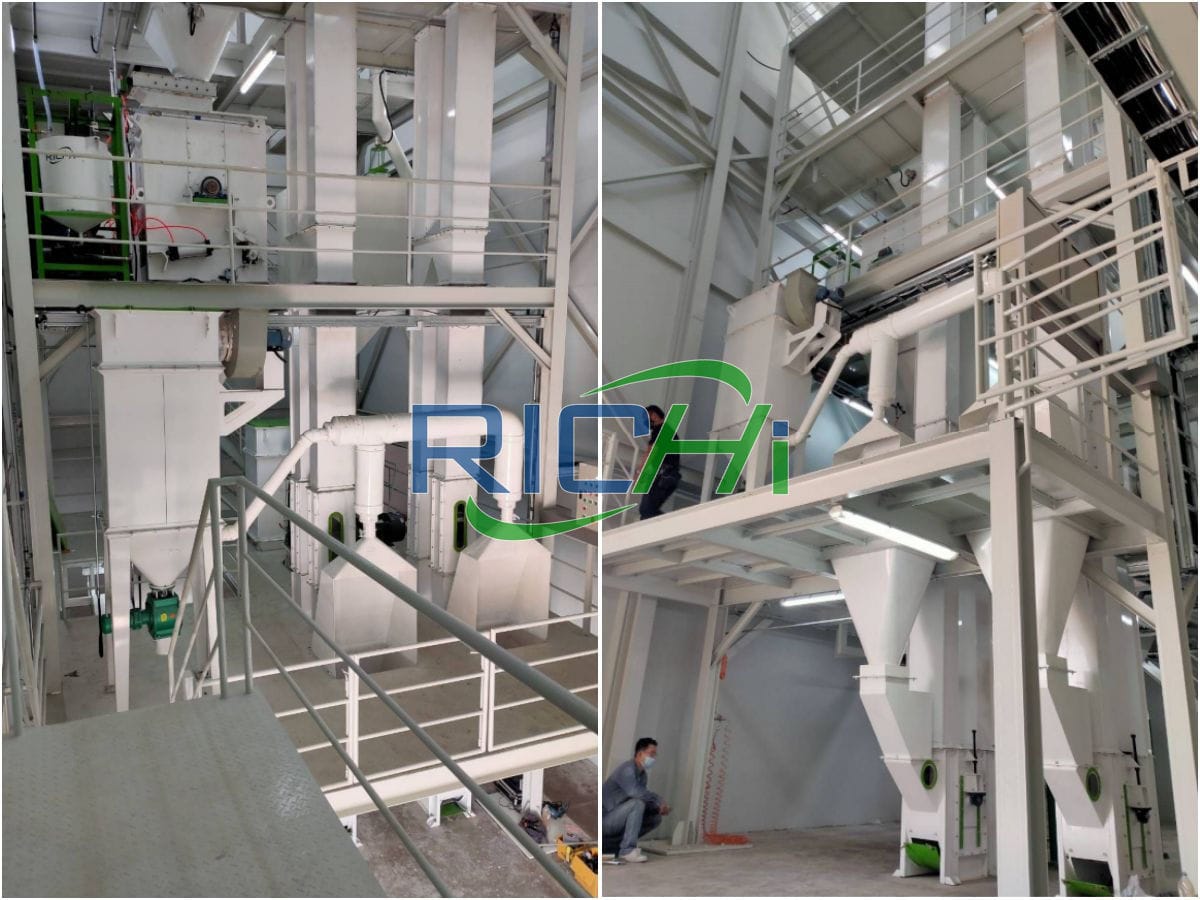
Requirements for bucket elevators
The operating temperature of the motor and reducer is normal, the reducer does not leak oil, the reducer is installed reliably, the transmission is reliable, the lubrication conditions are normal, the protective cover is complete, the bucket belt in the machine is properly tensioned and there is no deviation, each bucket is in good condition, and the bucket belt tensioning mechanism is reliable and has no slipping phenomenon.
The bucket belt running check-back mechanism has reliable performance. The surface of the machine body is clean and dust-free, with no oil leakage or powder leakage. The machine body is well sealed and all signs are clear.
Requirements for central control equipment
It can meet duck feed machine system requirements. The operation and control system is complete, sensitive and reliable. Various switches and contactor contacts are in good contact. The arc clearing device and safety cover are complete and intact. Various contactors, relays and magnetic starters have reasonable capacities and contacts.
There are no serious burns, the armature is not stuck or delayed release or stuck, the electrical components are clean, the wiring is standardized, the wiring is neat, the signs are eye-catching, the indicator lights are intact, the operation is good, the insulation strength and safety protection devices comply with the electrical operating regulations.
The electrical equipment has good heat dissipation and ventilation, and has complete anti-rodent functions; the accuracy and production capacity of the batching scale meet duck feed machine plant requirements.
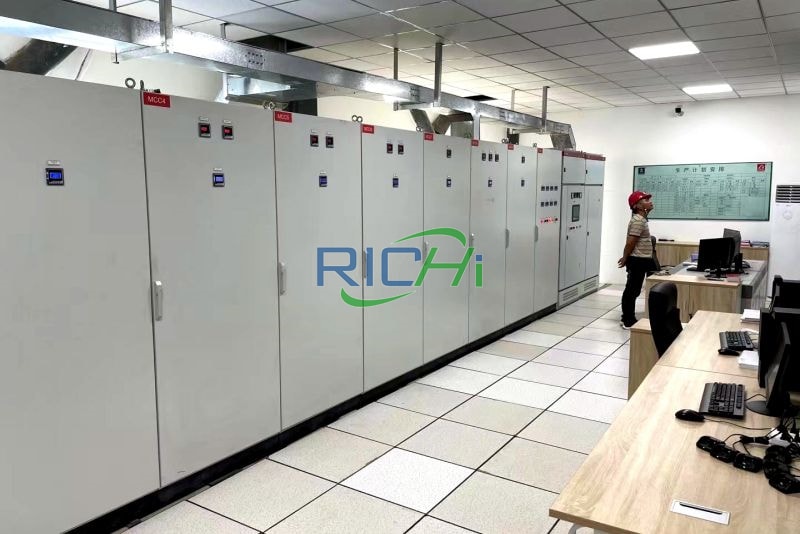
Why invest in duck feed production business?
In recent years, with the improvement of people’s living standards and changes in consumption concepts, more and more consumers have higher demands for high-quality duck meat products. In particular, the demand for duck meat market segments such as duck breast and duck legs is increasing.
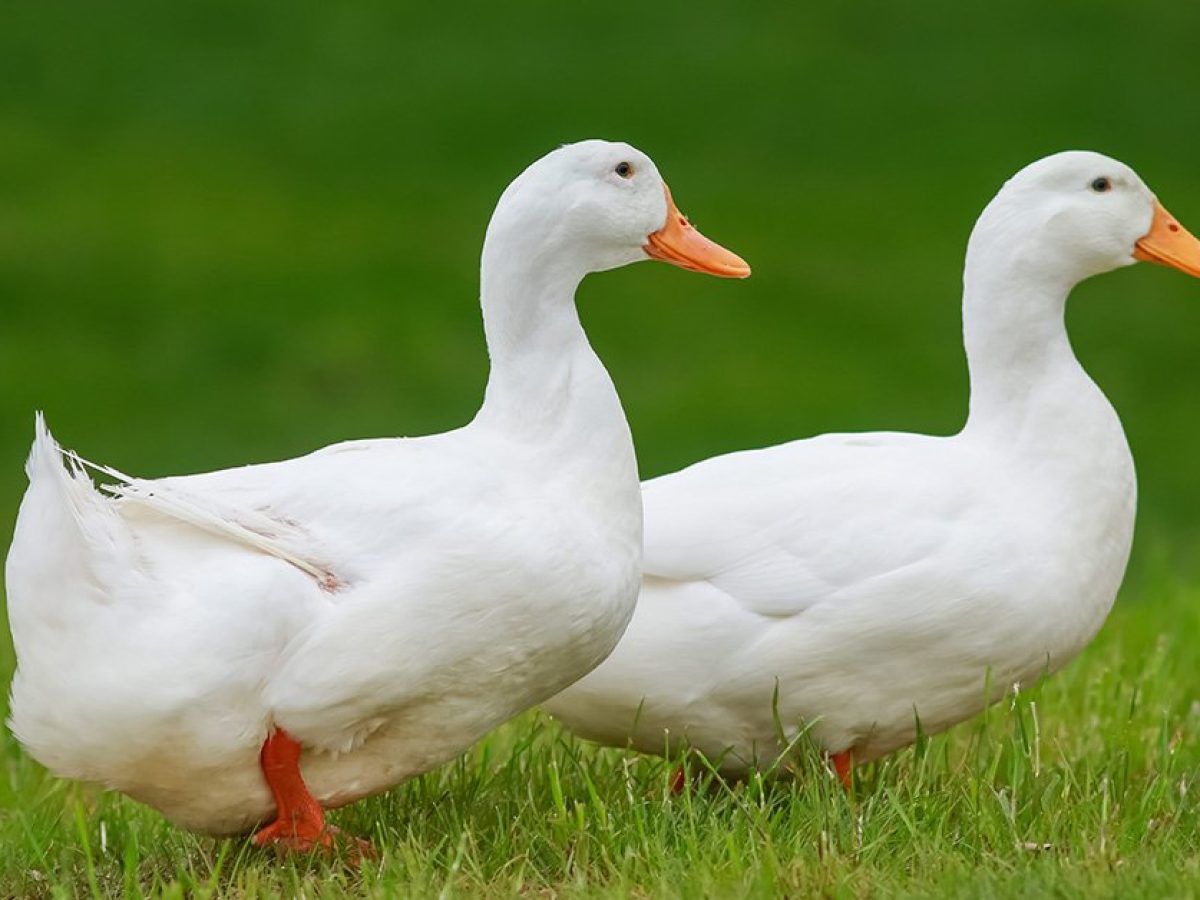
In addition to duck meat itself, the duck meat processed products market also has huge potential. Delicatessen products such as duck necks and duck legs are loved by consumers.
As consumers have higher and higher requirements for duck meat quality, the prospects of the duck feed industry are also good, and will gradually develop in the direction of specialization and customization. Enterprises that produce duck feed need to focus on product research and development and production technology. Improve to meet the needs of different consumers.
As society’s requirements for environmental protection are increasing day by day, green environmental protection has become the development direction of the feed industry. Duck feed companies need to increase the research and development and application of environmental protection technologies to improve the environmental protection of products and reduce environmental pollution.
Faqs of duck feed machine

Powder, pellets or crumbs feed, which one is most suitable for meat ducks?
The feed for meat ducks is divided into powder, pellets and crumbles feed according to the shape.
- Powder is the easiest to produce and is less expensive. It has the advantages of simple processing, comprehensive nutrition, low cost, convenient dosing, and the remaining materials are not easy to go moldy. It is a material commonly used by small and medium-sized free-range farmers. The disadvantage is that the powder easily produces dust.
- The pellet feed is made of full-price material plus a binder and then pressed. The particle size is adjustable to adapt to the nutritional needs of meat ducks at different growth stages. Ensure that when meat ducks eat feed, all nutrients are eaten in a balanced manner.
Pellets can also improve palatability, increase the feed intake of meat ducks, and make it easier to obtain the nutrients required for meat duck production performance; make meat ducks less picky eaters, and reduce feed waste. Due to the high temperature requirements during the granulation process, it is also a sterilization process for Salmonella and other harmful bacteria.
During the processing of pellets, the carbohydrates in the feed are gelatinized (gelled), improving the digestibility of the feed. From a feeding science point of view, it is best to feed meat ducks pellet feed because it is nutritious and has good palatability.
It increases the eating speed and amount of meat ducks, reduces the energy consumption of eating movements, and improves the feed conversion rate, meat ducks also gain weight quickly. The disadvantage is that certain vitamins are easily destroyed due to high temperatures during processing.
In addition, ducks like to eat granular feed rather than powdered feed. A high powdering rate will affect feed intake and loss rate. Ducks are sensitive to changes in particle size. Therefore, it is best to feed meat ducks with pellet feed.
RICHI’s duck feed machine can process various duck feed products. The duck feed machine and processes we configure for our customers completely depend on “what kind of duck feed the customer wants to process.”

What are the methods of processing duck feed?
In fact, there is more than one way to process duck feed:
- Crushing and flattening:
Crushing is the most common method of grain feed processing, and the processed products include coarse grains and fine grains. Young ducks should be fed fine grains, and adult ducks should be fed coarse grains. This will help improve the palatability of the feed, increase the duck’s feed intake, and improve feed digestibility.
Flattening is to heat the grains with steam to about 120°C, and then use a flattening machine to crush them into 1 mm thick slices, which are quickly dried. Since the starch in the feed is heated and gelatinized during the flattening process, the digestibility of the feed can be improved. - Granulation:
That is, making granulated ingredients. After crushing the feed, mix various raw materials evenly according to the feed formula, and then use a duck feed pellet making machine to form granular shapes.
The advantages of pellet feed are that it is convenient to feed, has good palatability, can increase chewing time, is beneficial to digestion, and reduces feed waste. This is also the process of duck compound feed that has been introduced above. It only needs to use a complete set of duck feed equipment. This method is also the most widely used. - Soaking:
Some feeds such as bean cakes and cottonseed cakes are quite hard and difficult to chew when fed directly, so they need to be soaked to allow the feeds to absorb water and expand, making them soft and easy to chew. The soaking method is to mix the feed with water in a container such as a pool or tank.
The general ratio of duck feed to water is 1:1 to 1.5, that is, just hold the water droplets between your fingers. For feeds containing harmful substances such as tannins and gossypol, soaking can reduce toxins and their bad taste and improve palatability. Note that the soaking time should be adjusted according to the season and feed type to prevent feed deterioration. - Feed formulation and mixing:
This is the main method of modern compound duck feed production. Its purpose is to produce high-quality feed by formulating according to the nutritional needs of ducks and mixing according to processing requirements, and greatly improve the digestibility of the duck feed.

What is duck feed made of?
Duck feed plays a vital role in the overall health and growth of ducks. The composition of duck feed can vary depending on the specific needs of the ducks and the type of production system used. However, there are some common ingredients included in most duck feeds.
- Grains: Grains such as corn, barley, wheat and oats are the main energy sources in duck feed. They provide the necessary carbohydrates and proteins required for growth. Corn is the most commonly used grain in duck feed because it is readily available, palatable and provides an excellent source of energy.
- Protein: Ducks require a high-protein diet to support their growth and maintain their feathers and muscle mass. Animal proteins such as fish meal, meat and bone meal, and soybean meal are often used in duck feed to provide essential amino acids.
- Fat: Fat is an important energy source for ducks and helps to increase the overall energy density of feed. Vegetable oils such as soybean oil, corn oil, and canola oil are commonly used as a source of fat in duck feed.
- Minerals: Ducks need a variety of minerals to support their growth. These include calcium, phosphorus, sodium and potassium, which are all essential for the development of strong bones and maintaining proper body function.
- Vitamins: Ducks need a variety of vitamins to support their growth and overall health. These include vitamins A, D, E, K and B-complex vitamins. Vitamin supplements are often included in commercial duck feeds to ensure the ducks get all the vitamins they need.
- Fiber: Fiber is an important component of duck feed as it helps promote digestive health and prevent digestive diseases. Sources of fiber in duck feed may include alfalfa meal, wheat bran and other fiber by-products.
In summary, duck feed is a complex mixture of ingredients that must be carefully balanced to meet the specific needs of ducks. A good quality duck feed should provide all the essential nutrients, vitamins and minerals required for growth, maintenance and good health.

How to control the powder content during the operation of duck feed machine?
Controlling the powder content of duck feed actually means controlling the starchy raw materials such as corn, wheat, and cassava in duck feed.
- Corn: The binding force between protein and starch granules is weak, the structure and texture are soft, and there are air gaps in the endosperm.
- Hard wheat: The binding force between protein and starch granules is strong, the structure is tight, and the texture is hard.
- Cassava: The protein structure is denser and harder than that of wheat.
We already know that for this difference in starch raw materials, we should:
- In view of the structural strength and hardness of wheat and cassava starch, the fineness of crushing should be increased and the proportion of damaged starch should be increased as much as possible.
- In view of the tight structure of wheat and cassava starch, the conditioning time should be appropriately extended and the conditioning temperature should be increased before granulation.
- Conditioning time: no less than 25 seconds
- Conditioning temperature: The surface temperature of the duck pellet machine conditioner should not be lower than 90°C, and the material temperature should be kept above 80°C.

Can your duck feed machine process fermented duck feed?
Sure. We can supply whole set of fermented feed machine for duck feed mills.
1. Preparation and application methods of fermented feed
- Fermented complete feed: 2 tons of complete duck feed (you can also mix soybean meal and corn half and half), 1-2 packs of “feed starter”, 1-1.2 tons of clean water, seal in a plastic container and ferment for more than 7 days. Mix it with duck feed at a ratio of 10%-30% and feed it. You can also feed it alone according to this ratio, and it should be staggered with the full-price feed.
- Fermented cheap feed:
Such as fermented cassava dregs, bean dregs, rice noodle processing leftovers, factory and school leftovers, rice bran, uniform bran, fungus bran, distiller’s grains, pomace peel, green straw, pasture, sweet potato vines and other raw materials 99 multi-functional 1 pack of feed starter and 1 ton of raw materials to be fermented (some raw materials need to be crushed), 100 kilograms of starch-containing feed (the proportion is about 5% or more of the raw materials, such as corn, rice, sweet potatoes, and starch, or more than 1 kilogram of polysaccharide compound bacterial strain nutrient base instead), 2 kilograms of salt (raw materials containing sufficient salt will not be added.- Salt cannot be placed in the activated bacteria, but should be sprinkled directly on the fermentation material or in the clear water that needs to be added. ).
- The moisture content is adjusted to about 55%-60%, and it can be used when it is compacted, sealed and fermented for about 7 days and has a strong aroma.
- The palatability, nutrition, and digestibility of the fermented material are significantly improved compared to those before fermentation.
- The fermented feed should be mixed with other full-price feeds of the animal at 10%-50% according to different animals and different feeding cycles and then fed. It cannot be fed alone or fed with all fermented feeds.
It should be noted that processing fermented feed does not mean not processing pellets. Fermentation is a type of process, and the form of pellets is what ducks like to eat. Therefore, duck feed machine can still be used to process fermented feed and used together with fermentation equipment.
2. Benefits of fermented feed for ducks
It is very difficult to improve the economic benefits of large-scale meat duck breeding if all the ducks are raised with full-price feed. Coupled with transparent competition, it is difficult to win more benefits except through quantity.
Most farmers know that poultry have short intestines and poor digestion of feed. Ducks are no exception. Only a part of the feed will be digested and utilized by ducks, and the remaining nutrients will be excreted from the body before they are absorbed. , causing great waste. In order to avoid this situation, improve feed utilization and reduce feed costs, many people began to try to use fermented feed to raise ducks. Facts have proved that the effect of fermented feed did not disappoint them.
There are two main reasons for the low utilization rate of ducks fed ordinary feed.
- First, the duck’s own intestinal tract is short, and the digestion time of the feed is short. There is not enough time for the duck to slowly decompose and utilize the feed.
- Second, most of the general feeds are corn, bran and other feeds that contain a lot of crude fiber and lignin. Ducks themselves have poor digestion ability.
- In addition, the feeds they feed are macromolecular substances that are difficult to be digested and absorbed by animals, so the utilization rate of feed will certainly not be very high.
Fermented feed uses organic acids produced by the reproduction of beneficial microorganisms to soften and decompose the feed, and convert macromolecules such as crude fiber and lignin in the feed that are difficult to be digested and absorbed by animals into small sugars such as simple sugars and amino acids that are easily utilized by animals.
Molecular nutrients save ducks the time of decomposing the feed and can be digested and absorbed directly. The utilization rate of the feed will naturally be improved.
The fermented feed contains many beneficial microorganisms. The organic acids produced by these microorganisms when entering the duck’s body along with the feed will regulate the acid-base balance in the duck’s intestines, promote intestinal peristalsis, enhance the duck’s own ability to digest the feed, and further improve the duck’s ability to digest the feed. Feed utilization.
Using fermented feed to raise ducks can save 10% to 20% of feed costs. Although it may not seem like much, it can save farmers a lot of feed expenses on a huge base, reduce the economic investment in breeding, and increase breeding in disguise. the economic benefit of the person.

How to prepare meat duck feed?
Meat duck feed preparation technology requires reasonable configuration of duck feed ingredients and proportions, mainly including energy, protein, fat, fiber, minerals and vitamins.
- According to the nutritional needs of meat ducks at different stages, appropriate raw materials should be selected and mixed in proportion for processing.
- At the beginning of the growth period, feed mainly high-protein, high-energy, and easily digestible feeds, such as soybean meal, corn, fish meal, etc.;
- In the middle and late growth period, the crude fiber content should be increased appropriately, such as silage corn or pea seedlings, etc.
- In terms of the type and use of meat duck feed, complete feed, concentrated feed, concentrate and additives can be used.
- Complete compound feed ingredients include corn, soybean meal, wheat bran, etc., which can meet various nutritional needs of meat ducks;
- Concentrated feed refers to high-quality feed that has been concentrated, such as corn lactic acid bacteria fermentation liquid, wheat germ, etc.;
- Concentrated feed is a highly nutritious feed made using modern technology, such as amino acid, nucleic acid feed, etc.;
- Additives can improve the nutritional value and taste of feed, such as enzymes, etc.

What should you pay attention to when using duck feed machine to produce fat-containing laying duck feed?
When using duck feed equipment to produce fat-containing laying duck feed, the following aspects should be paid attention to:
- Add oil: Add more than 3% palm oil when mixing.
- Ring die aperture: Φ4.0 or Φ4.5
- Quenching and tempering temperature: has reached 100℃, ring die compression ratio: has been used to 1:16 or 1:19, but the problem of powder content still cannot be solved.
We believe that when adding a large proportion of grease and enzyme preparations, which seriously affects the granulation and molding, you may wish to choose spraying after granulation. There are three suggestions as follows:
- Difficult to spray: Use a screw pump (4KW) without adding water, heating and temperature control of 60°C, pressure of 6 kg, and lift of 30 meters.
- Molasses: (vertical) viscosity 79-80%.
- Difficult to granulate: The resistance through the inner hole of the die hole is large, so appropriately reduce the compression ratio of the duck feed pellet machine ring die

Special problems arising from the use of mineral raw materials in duck feed
(1) Stainless steel ring molds cannot be used for laying duck feed
The quenching hardness of stainless steel ring dies is generally only HRC.52–54, while the quenching hardness of alloy steel ring dies reaches HRC.59–63.
The feed for laying ducks not only has a high crude fiber content, but also the most terrible mineral content, especially the use of shell powder, low-grade bentonite, stone powder and other raw materials. Mineral raw materials are inorganic substances and cannot be gelatinized or softened despite being tempered. Mineral components that cannot be softened will definitely cause abnormal wear on stainless steel ring dies with low hardness.
(2) Irregular wear similar to hexagonal holes or multi-angular holes appears in the inner hole of the ring die
Reason: When using shell powder, it cannot be crushed, and the raw material particles are too large. When passing through the inner hole of the ring die, the inner hole will be scratched, causing the die hole to vary. A more realistic control measure is to adjust the mineral content and crush the raw material. Fineness.
(3) Analysis of cellular wear
Livestock and poultry feed using ring dies, especially duck feed with a large proportion of crude fiber and mineral content, are more likely to appear honeycombed when using ring dies. This is mainly due to poor discharging and the circumferential damage to the bell mouth of the ring die caused by extrusion friction. , the appearance of honeycomb can be solved by improving the tempering and ring mold design, rather than the usual saying that honeycomb is normal.

Can you provide some feed formulas for meat ducks?
- Duckling feed formula:
50% Corn, 20% vegetable cake, 10% broken rice, 10% bran, 7.5% fish meal, 1% meat meal, 1% shell meal, and 0.5% salt. - Feed for middle-aged ducks and fattening period:
Corn 50%, wheat 17%, bran 12%, broken rice 10%, vegetable cake 5%, fish meal 4.5%, shell powder 1%, salt 0.5%. - Feed formula for 0-3 weeks old
- Corn 52.1%, sorghum 10%, soybean meal 23%, fish meal 5%, bran 6%, molasses 1%, calcium hydrogen phosphate 1.1%, calcium carbonate 0.5%, salt 0.3%, premix 1.0%.
- Corn 52.6%, sorghum 10%, soybean meal 22%, fish meal 2.5%, meat and bone meal 3.5%, bran 6%, molasses 1.5%, calcium hydrogen phosphate 0.25%, calcium carbonate 0.35%, salt 0.3%, premix 1.0%.
- 4 Weeks old – feed formula when sold
- Corn 47.2%, sorghum 20%, soybean meal 16%, fish meal 4%, bran 8%, butter 0.4%, molasses 2%, calcium hydrogen phosphate 1.1%, calcium carbonate 0.5%, salt 0.3%, premix 0.5%.
- Corn 45.2%, sorghum 20%, soybean meal 18.5%, meat and bone meal 4.0%, bran 8%, butter 0.8%, molasses 2%, calcium hydrogen phosphate 0.6%, calcium carbonate 0.1%, salt 0.3%, premixed feed 0.5%.

What‘s the ’Feed formula for laying ducks
In the formula of duck layer feed, the requirements for the selection of raw materials are: stable quality, sufficient quantity, appropriate price, and local resource advantages to reduce feed costs.
Formulate the laying duck diet according to the duck’s age group and feed intake, and determine the appropriate nutrient concentration of the compound duck layer pellets.
Reference duck layer feeds formulation:
- Egg-laying ducklings (1 week to 8 weeks): 58.7% corn, 26% soybean meal, 7% rapeseed meal or cotton meal, 4% stone meal (both bone meal and shell meal are acceptable), special No. 6 premix 4 %, salt 0.3%. It is recommended that all ducklings be fed full-price pellet feed in the first week.
- Duck in the egg (8 weeks to start of production): 64% corn, 16% soybean meal, 6% rapeseed meal or cotton meal, 9.7% stone meal (both bone meal and shell meal are acceptable), special No. 6 premix 4 %, salt 0.3%.
- Ducks during laying period: corn 51%, soybean meal 22%, rapeseed meal or cotton meal 3%, secondary meal 10%, stone meal 9.7% (both bone meal and shell meal are acceptable), special No. 6 premix 4% , salt 0.3%.

Regarding lubrication of duck feed machine
Equipment lubrication is an important means to prevent and delay parts wear and other forms of failure. Lubrication management is one of the most basic and critical tasks in equipment management, and is a vital link in the “management, use, maintenance, and repair” of equipment.
Strengthening the lubrication management of equipment will ensure the normal production of enterprises, reduce the physical wear and tear of equipment, and extend the life of equipment.
The service life and replacement cycle of parts are of great significance to reduce equipment accidents and failures and improve the economic benefits of enterprises.
The “five determinations” and “three filters” system of duck feed machine lubrication are specific systems for standardized management of equipment lubrication in enterprises and cannot be ignored.
(1) The “Five Certainties” are designated points, quality, quantity, regularity, and people.
- Fixed point. Determine the lubrication parts and lubrication points of each piece of equipment, keep them clean and intact, and implement fixed-point lubrication.
- Determination of quality. Use oil according to the grease brand specified in the lubrication card. Lubricating materials and blended oils must be inspected and qualified. The lubrication device and refueling equipment must be kept clean.
- Quantitative. On the basis of ensuring good lubrication, implement daily oil consumption quotas and quantitative oil changes, and do a good job in waste oil return, carry out warehouse withdrawal work, control equipment oil leakage, and prevent waste.
- Regularly. Refuel, add oil and clean oil according to the cycles specified in the lubrication card. For oil with large reserves, sampling and testing should be carried out according to the specified time. The cleaning, oil replacement, cycle filtration and sampling inspection cycles should be determined according to the oil quality.
- Appoint someone. According to the provisions on the lubrication chart, the division of labor among operators, maintenance workers and lubricators for daily refueling, refueling, cleaning and oil changing of the equipment shall be clearly defined, each shall perform their own responsibilities, supervise each other, and determine the person to submit samples for inspection.
(2) “Three filters”
The “three filters” are storage filtering, distribution filtering, and refueling filtering. This is a purification measure taken to reduce the content of impurities in the oil and prevent impurities from entering the duck feed machine with the oil. Specifically:
- When the oil is pumped from the input reservoir to the oil tank for storage, it must be strictly filtered;
- The oil must be filtered when injected into the lubrication container (distribution filtration);
- When the oil is added to the oil storage area of the equipment, it must also be filtered first (refueling and filtering).

What matters should be paid attention to in the lubrication of duck feed machine?
In work practice, nearly half of the causes of duck feed machine failure are due to poor lubrication. Reasons for poor lubrication include improper oil use, blocked oil passages, contaminated oil, incorrect refueling methods, and untimely oil changes. Poor lubrication will lead to increased mechanical wear and mechanical failure.
(1) Correctly choose lubricating oil
Select according to the type and label specified in the equipment manual. However, it is worth noting that equipment manufacturers often do not have a complete understanding of the production of lubricating oil products, and the oil product recommendations are often low or high, so they need to be revised based on the actual operation of the duck feed machine.
(2) Prevent abrasive wear
Abrasive wear is abnormal wear caused by the presence of worn particles (fine sand, iron filings, dust, etc.) on the two friction surfaces. It causes extremely serious wear and tear on machinery. Therefore, during the maintenance and lubrication of equipment, special attention must be paid to abrasive wear. The source of abrasive particles is related to maintenance operations and lubrication quality, as well as to the dust content in the atmosphere.
The support points of some machine rotating parts are susceptible to dust pollution. If maintenance and lubrication management are not good, dust remaining at the lubrication points during installation, dust invading from the outside due to poor sealing, contamination caused by poor management of lubricating grease, and poor running-in during initial operation.
Metal powder, poor lubrication system filtering device, etc. can cause abrasive wear, increase friction resistance, and intensify mechanical wear. Abrasive wear has a great impact on the life of machinery.
According to statistics, wear and tear damage accounts for about 50% in industry. It is regarded as the enemy of duck feed machine damage and should be paid enough attention to.
(3) Perform lubrication duties conscientiously during maintenance
During maintenance, the replacement of accessories and lubricating oil should be done carefully. When replacing duck feed machine accessories, the rag used for wiping must be clean. The rag used for wiping important parts should be cleaned before use to avoid dust contamination of the accessories. The lubricated parts of newly replaced accessories.
The installation area must be thoroughly cleaned. For newly replaced gears in the gearbox, they should be run-in, cleaned again and lubricated before being put into normal operation.
If the bearing is a sealed bearing when replacing the bearing, grease has been added to the bearing, so there is no need to add more grease. During installation, protect the sealing cover and be careful not to damage it to avoid grease spillage and dust intrusion; and hot installation is not allowed during installation to prevent lubrication. The grease melted and overflowed.
At the same time, pay attention to cleaning work when replacing bearings. Dust, impurities or moisture in the lubricating grease will cause greater wear on the bearings. When the content of impurities increases to 0.5%, the wear can increase 5 to 10 times. The amount of grease added should be appropriate, generally 1/2 to 1/3 of the bearing cavity.
(4) Master the special requirements for feed machinery lubrication
Feed is used to feed animals, and its safety is very important for feeding and production. The toxic and side effects of pollution on the feed cannot be ignored. This adds special requirements to the lubrication of duck feed machine: equipment lubrication must not contaminate the processed materials to avoid affecting feed quality. In order to meet this requirement, remedial measures have been taken in the design of feed machinery.
First, strict sealing devices are set up in parts that need lubrication, such as packing seals, mechanical seals, labyrinth seals, floating ring seals, etc., to prevent lubricant leakage; second, special materials that do not require lubrication are used, such as oil-containing bearings, to prevent equipment from leaking.

How to maintain the wearing parts of duck feed grinder machine
(1) Precautions when using the crusher for duck feed
- The duck feed pulverizer should be fixed on a dedicated foundation for long-term operation.
- After installing the crusher, check the tightening condition of each fastener. If there is any looseness, tighten it.
- Check whether the tightness of the coupling is appropriate and whether the motor shaft and the duck pulverizer machine shaft are parallel.
- After starting up, the crusher should be idle for 2~3 minutes, and then start feeding after there are no abnormal phenomena.
- Pay attention to the operation of the duck feed pulverizer machine at all times during work, and feed the material evenly to prevent clogging of the machine. Do not overload the machine for a long time.
- When it is clogged, stop the machine immediately. It is strictly forbidden to open the cover when starting up.
(2) Wear mechanism of duck feed pulverizer hammer machine
Duck feed hammer mill machine is one of the most commonly used duck feed machine. The rotating speed of the rotor is 1 500~3 000 r/min. Arrays of hammer blades (ranging from 20 to 100 pieces) are evenly distributed in the radial direction on the rotor and rotate at high speed at a linear speed of up to 60~100 m/s, thereby putting the input into the hammer.
Soybeans, corn and other grains in the crushing chamber are impacted and crushed. Since these grains are inevitably mixed with a certain amount of impurities, the corners of the hammer will be worn quickly.
A scanning electron microscope was used to observe the surface morphology of the worn parts of the hammer. From the analysis of the wear streaks and pits with obvious directionality, it was found that oblique impact particles have certain cutting wear and deformation fatigue wear effects on the surface of the hammer.
Nowadays, hammer manufacturers generally use heat treatment to improve the strength and surface hardness of the hammer to extend the service life of the hammer. In order to improve production efficiency, duck feed manufacturers should regularly check the wear degree of hammer blades and replace worn parts in a timely manner.

How to maintain duck feed pellet machine?
(1) Precautions during the granulation process
- The material needs to be quenched and tempered before granulation. The pressure of the steam must be stable (0.2 mbar), and the water must be removed from the steam before quenching and tempering. If the steam contains a large amount of moisture, it will cause clogging of the granulation. After the materials are conditioned, they undergo a certain degree of maturation, which can significantly improve the utilization rate of nutrients in the feed.
- During the granulation process, the humidity and temperature of the material should be checked frequently. The way to check the humidity is to check if the material can form lumps after gently pinching it with your hands. The temperature should vary according to different granulation varieties, and should be stably controlled between 75°C and 95°C.
- The particles after granulation must not be cooled too quickly or not cooled enough. If the cooling is too fast, the surface of the material particles will crack; if the cooling is not enough and the temperature is too high, the material will absorb moisture and cause mold. The cooled material should be consistent with room temperature.
(2) Correct operation and maintenance of duck feed pellets machine
- Adjustment of the gap between the ring die and the pressure roller.
For the adjustment of the gap between the new ring die and the pressure roller, there should be slight contact between the highest points of the ring die and the pressure roller, and the pressure roller reaches a state of “seeming to rotate but not rotating”.- If adjustments are made during working conditions, the pressure on the ring die and the pressure roller can be appropriately increased, but it must be done only in moderation.
- If the gap between the ring die and the pressure roller is too large, the pressure roller cannot rotate, causing the machine to jam.
- If the gap between the ring die and the pressure roller is too small, the wear of the ring die and the pressure roller will increase, and even the ring die and the pressure roller will be damaged.
- For this reason, the gap between the ring die and the pressure roller should be checked in time, at least once every 4 hours of work. When adjusting each pressure roller, pay attention to the adjustment direction of each pressure roller. The sum of the moments of each pressure roller relative to the axis of the duck feed pellet machine should be 0, so that the duck feed pellet machine is not affected by asymmetric forces.
- The team maintains the duck feed pellet machine.
A pre-shift inspection should be conducted before each shift to check all transmission components, instruments, and valves, add lubricating oil (lithium-based lubricating oil should be used), and remove iron filings from ironware. - Install or replace the ring die and pressure roller correctly.
Generally, new molds are equipped with new rollers, and old molds are equipped with old rollers, so that the surface shapes of the ring mold and the pressure roller are close to the profiling state.- The gaps between the various parts of the ring die and the pressure roller are roughly the same, so that the entire ring die is stressed and discharged very evenly, which can improve production efficiency. Before assembly, cleaning work should be done to ensure that all mating surfaces are clean.
- Pay special attention to cleaning the screw holes of the ring die. If there is material in the screw holes of the ring die that is not cleaned, it will easily cause the bolt holes of the ring die to break when tightening the bolts of the ring die. Use a torque wrench to tighten the ring die bolts to ensure the specified tightening torque.
- When assembling the pressure roller, pay attention to the inspection of the bearing. Once damage is found, it should be replaced in time. After assembling the pressure roller, a certain gap should be ensured so that the pressure roller can rotate freely.
- Be sure to oil the pressure roller on time every shift. If the pressure roller is short of oil, it will cause the bearing and pressure roller shaft to burn, and in severe cases, the entire pressure roller will be scrapped.
The starting point of duck feed machine care and maintenance is to ensure the normal operation of the equipment, save energy, reduce maintenance costs, and extend the service life. The fundamental purpose is to improve the comprehensive economic benefits of the enterprise. Although the company’s mechanical maintenance costs only account for a small part of the company’s production costs, it can have a great impact on the company’s long-term economic benefits.
The damage caused by inadequate equipment care and maintenance is serious, especially when key duck feed machine is damaged. Due to the long procurement cycle of spare parts, it will cause long downtime and stop production, which will affect the completion of the production plan and cause heavy losses to the company’s profits.
All duck feed production enterprises should strengthen the maintenance and upkeep of feed mill equipment to ensure the economic benefits of the enterprise.

Principles of using duck feed machine to process duck feed
(1) Pay attention to safety:
When formulating duck pellets, safety should be given top priority. Only by first considering the safety of the formula feed can we carefully select materials and use them rationally.
- Prudent selection of materials means paying attention to the quality and grade of the feed. It is best to test various duck feeds before batching to make sure you are aware of it.
- Pay attention to whether the feed has deteriorated and whether it is contaminated with toxins. Any duck feed that is moldy, spoiled, or contaminated with toxins is not allowed to be used.
- The dosage of duck feed containing toxic substances must be strictly controlled to ensure rational use of materials to prevent poisoning.
- It is necessary to fully estimate the possible toxicity of some additives and comply with the regulations on their use period and discontinuation period.
(2) Pay attention to nutrition
Nutrition is based on feeding standards, combined with local natural conditions and practical experience, to design a formula that can meet the nutritional requirements of high-yielding poultry and fully unleash the high-yielding potential of the poultry flock.
Whether the duck feed formula is practical depends on whether the various nutrients in the prepared feed synergize and complement each other. Only with reasonable compatibility can the potential of duck feed be maximized.
(3) Give full play to benefits
The ultimate goal of compound feed is to achieve good economic benefits. Only duck feed formulas with reasonable nutritional content, good production performance, high feed conversion rate and high economic benefits after feeding duck have practical significance. When large-scale duck farmers formulate their own feed, they can reduce an intermediate link, which can save costs.

RICHI Machinery—— duck feed machine manufacturer
Richi Machinery has been linked to the poultry feed sector since 1995 and covers every process within the duck feed plant. Today RICHI is the leading Chinese company in the production of animal poultry chicken goose duck feed machines and turnkey cattle feed plants.
We design, build, assemble and start up our complete duck feed mill plants with hourly production ranging from 1 to 100 tons/h. Our duck feed manufacturing machines and duck feed pellet plants are present in 5 continents.
If you want to start a duck feed processing business, welcome to contact us for a customized semi-automatic and fully automatic duck feed plant plan and duck feed machine quotation!